Contents
- 1. Manual 1
- 2. Manual 2
- 3. User Manual
Manual 1
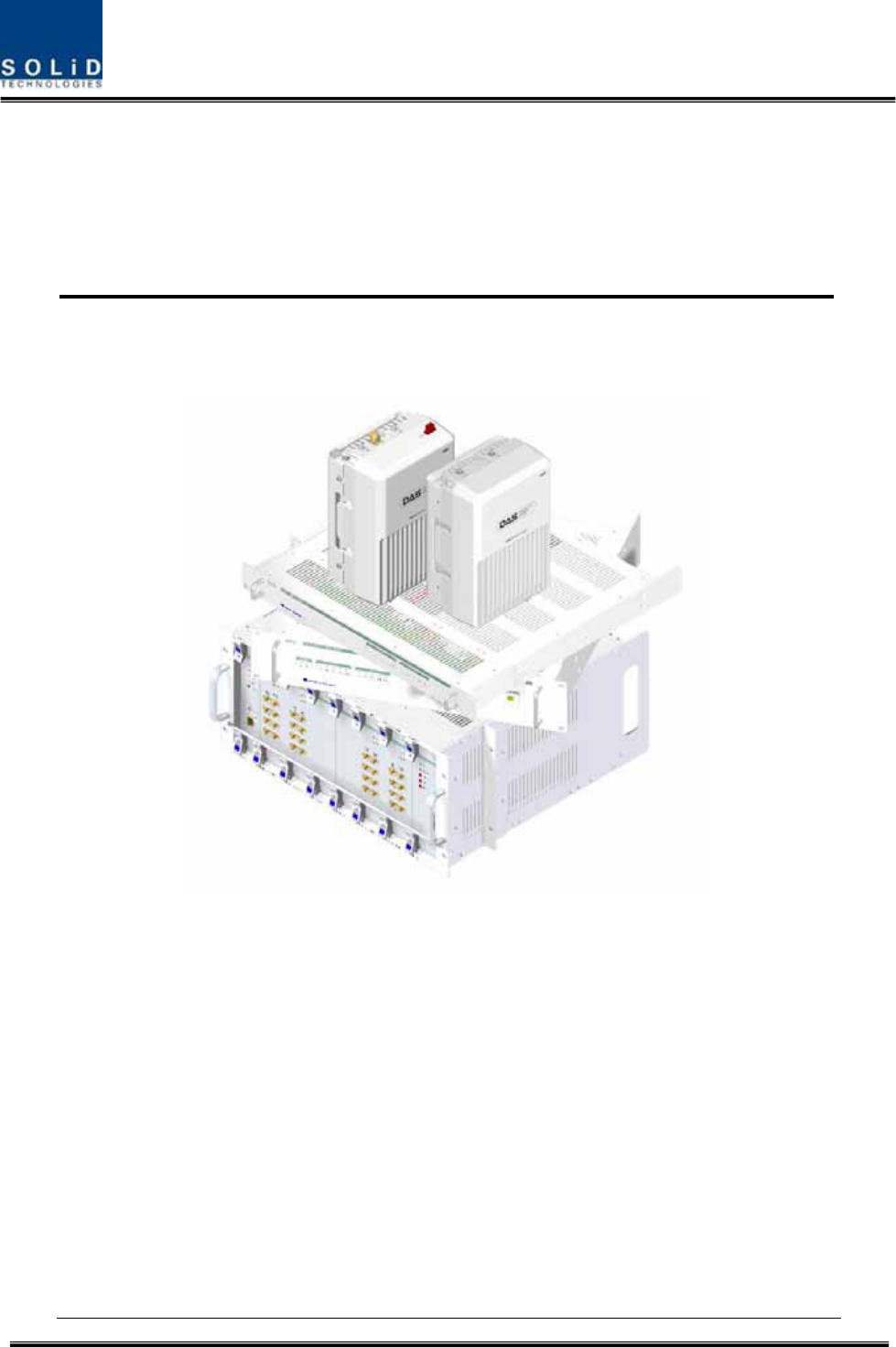
Confidential & Proprietary 1/116 SC-DAS
SC-DAS
Installation and Operation Manual
Document Reference:
Version: V1.0
Document Status: Release 1
Issue Date: April. 11, 2011
Author: Kyung Eun Han
Department: R&D Division Team 3
Authorizing Manager: Youngshin Yeo

Confidential & Proprietary 2/116 SC-DAS
REVISION HISTORY
Version Issue Date No. of
Pages Initials Details of Revision Changes
V 1.0 April. 11, 2011 Original
Technical Support
SOLiD serial numbers must be available to authorize technical support and/or to establish a return
authorization for defective units. The serial numbers are located on the back of the unit, as well as on
the box in which they were delivered. Additional support information may be obtained by accessing
the SOLiD Tehcnology, Inc. website at www.st.co.kr or send email at sjkim@st.co.kr
This manual is produced by Global Business Division Business Team 1. Printed in Korea.

Confidential & Proprietary 3/116 SC-DAS
Contents
Section1
Safety & Certification Notice
..................................................................... 10
Section2
System Overview
...................................................................................... 12
2.1 General overview ............................................................................................. 13
2.2 System overview ............................................................................................. 15
Section3
System Specifications
............................................................................... 18
3.1 System specifications...................................................................................... 19
3.1.1 Physical Specifications .............................................................................. 19
3.1.2 Optical wavelength and Laser power .......................................................... 20
3.1.3 Environmental specifications...................................................................... 20
3.1.4 Operating Frequencies range ..................................................................... 20
3.1.5 Specifications Per band ............................................................................. 21
Section4
System Configuration and Functions
.......................................................... 22
4.1 BIU (BTS Interface Unit).................................................................................. 23
4.1.1 Specifications of BIU ................................................................................. 23
4.1.2 Block diagram of BIU ................................................................................. 24
4.1.3 BIU parts .................................................................................................. 24
4.1.4 Function by unit ........................................................................................ 25
4.1.5 Front/Rear panels of BIU .......................................................................... 29
4.2 ODU (Optic distribution Unit) ........................................................................... 32
4.2.1 Specifications of ODU ............................................................................... 32
4.2.2 Block Diagram of ODU............................................................................... 33
4.2.3 ODU parts................................................................................................. 33
4.2.4 Function by unit ........................................................................................ 34
4.2.5 Front/rear panels of ODU.......................................................................... 35
4.2.6 Interface with BIU ..................................................................................... 37
4.3 OEU (Optic Expansion Unit) ............................................................................. 39
4.3.1 Specifications of OEU................................................................................ 39
4.3.2 Block Diagram of OEU ............................................................................... 40
4.3.3 OEU parts ................................................................................................. 40
4.3.4 Function by unit ........................................................................................ 41
4.3.5 Front/rear panels of OEU .......................................................................... 44
4.4 ROU (Remote Optic Unit) ................................................................................ 45

Confidential & Proprietary 4/116 SC-DAS
4.4.1 Specifications of ROU ............................................................................... 45
4.4.2 Block Diagram of ROU............................................................................... 46
4.4.3 ROU parts................................................................................................. 46
4.4.4 Function by unit ........................................................................................ 48
4.4.5 Bottom of ROU ......................................................................................... 50
4.4.6 Top of ROU............................................................................................... 52
Section5
System Installation & Operation
................................................................. 53
5.1 BIU Installation ................................................................................................ 54
5.1.1 BIU Shelf Installation ....................................................................................... 54
5.1.2 BIU Power Cabling........................................................................................... 55
5.1.3 RF Interface at BIU ......................................................................................... 58
5.1.4 MDBU insertion ............................................................................................... 62
5.1.5 ODU Interface ................................................................................................. 64
5.1.6 Consumption Power of BIU .............................................................................. 68
5.2 ODU Installation .............................................................................................. 69
5.2.1 ODU Shelf Installation...................................................................................... 69
5.2.2 ODU Power Cabling ......................................................................................... 69
5.2.3 ODU Optic Cabling .......................................................................................... 69
5.2.4 Insert DOU to ODU ......................................................................................... 70
5.2.5 Consumption Power of ODU ............................................................................ 71
5.3 ROU Installation .............................................................................................. 73
5.3.1 ROU Enclosure installation............................................................................... 73
5.3.2 ROU Power Cabling ......................................................................................... 80
5.3.3 Optical Cabling ................................................................................................ 81
5.3.4 GND Terminal Connection................................................................................ 81
5.3.5 Coaxial cable and Antenna Connection............................................................. 82
5.3.6 Information of LED of ROU .............................................................................. 83
5.3.7 Consumption of RDU ....................................................................................... 83
5.4 OEU Installation............................................................................................... 84
5.4.1 OEU Shelf installation...................................................................................... 84
5.4.2 OEU Power Cabling ......................................................................................... 84
5.4.3 OEU Optic Cabling........................................................................................... 86
5.4.4 Insert DOU to OEU.......................................................................................... 87
5.4.5 Consumption Power of OEU............................................................................. 88
Section6
Operation
.................................................................................................. 89

Confidential & Proprietary 5/116 SC-DAS
6.1 BIU Operation.................................................................................................. 90
6.1.1 BIU ................................................................................................................. 90
6.1.2 TX Operation at BIU ........................................................................................ 90
6.1.3 RX Operation at BIU........................................................................................ 96
6.1.4 Tree window at BIU ......................................................................................... 97
6.1.5 ODU Operation at BIU ..................................................................................... 99
6.2 ROU Operation.............................................................................................. 100
6.2.1 ROU Operation.............................................................................................. 100
6.3 OEU Operation .............................................................................................. 107
6.3.1 OEU Operation .............................................................................................. 107
Section7
Additive functions
.................................................................................... 112
7.1 Shutdown function (TX output shutdown)....................................................... 113
7.2 Total Power Limit function (TX Output ALC).................................................. 113
7.3 Output power automatic setting function (TX Output AGC) ............................ 114
7.4 Input power AGC function (TX Input AGC) ..................................................... 114
7.5 Input power limit function (TX Input ALC) ...................................................... 115
7.6 Optical loss compensation ............................................................................. 115

Confidential & Proprietary 6/116 SC-DAS
Contents of Figure
Figure 2.1 – Basic system topology supporting SISO configuration..................... 15
Figure 2.2 – Basic system topology supporting MIMO configuration.................... 16
Figure 2.3 – Expansion system topology supporting SISO configuration .............. 17
Figure 2.4 – Expansion system topology supporting MIMO configuration ............. 17
Figure 4.1 – BIU outer view .............................................................................. 23
Figure 4.2 – BIU block diagram.......................................................................... 24
Figure 4.3 – BIU mounting diagram.................................................................... 24
Figure 4.4 – MDBU Outer Look ......................................................................... 26
Figure 4.5 – MCDU Outer Look......................................................................... 27
Figure 4.6 – MCPU Outer Look ......................................................................... 28
Figure 4.7 – MPSU Outer Look ......................................................................... 29
Figure 4.8 – BIU front panel Outer Look............................................................ 30
Figure 4.9 – Rear panel Outer Look................................................................... 31
Figure 4.10 – ODU Outer Look.......................................................................... 32
Figure 4.11 – ODU block diagram ...................................................................... 33
Figure 4.12 – ODU Inner Look........................................................................... 33
Figure 4.13 – DOU Outer Look.......................................................................... 35
Figure 4.14 – 2Way Divider Outer Look ............................................................. 35
Figure 4.15 – ODU front panel Outer Look ........................................................ 35
Figure 4.16 – ODU Rear panel Outer Look ........................................................ 36
Figure 4.17 – Interface between BIU and ODU .................................................. 37
Figure 4.18 – Interface between BIU and ODU at the back ................................ 37
Figure 4.19 – Interface between BIU and ODU more detail................................. 38

Confidential & Proprietary 7/116 SC-DAS
Figure 4.20 – OEU Outer Look.......................................................................... 39
Figure 4.21 – OEU block diagram ...................................................................... 40
Figure 4.22 – OEU Inner Look ........................................................................... 40
Figure 4.23 – DOU Outer Look.......................................................................... 41
Figure 4.24 – EWDM Outer Look ....................................................................... 42
Figure 4.25 – ECPU Outer Look........................................................................ 42
Figure 4.26 – ERFM Outer Look........................................................................ 43
Figure 4.27 – EPSU Outer Look ........................................................................ 43
Figure 4.28 – OEU front panel Outer Look......................................................... 44
Figure 4.29 – Rear panel Outer Look................................................................. 44
Figure 4.30 – ROU Outer Look.......................................................................... 45
Figure 4.31 – ROU block diagram ...................................................................... 46
Figure 4.32 – ROU Inner Look........................................................................... 47
Figure 4.33 – PSU Outer Look .......................................................................... 49
Figure 4.34 – ROU Bottom Look ....................................................................... 50
Figure 4.35 – ROU Power Port Look ................................................................. 51
Figure 4.36 – ROU Bottom Look ....................................................................... 52
Figure 5.1 – RACK Installation .......................................................................... 54
Figure 5.2 – Power interface diagrm.................................................................. 55
Figure 5.3 – PSU LED indicator information....................................................... 57
Figure 5.4 – BIU RF interface diagram............................................................... 59
Figure 5.5 – BTS interface directly ................................................................... 60
Figure 5.6 –BDA Interface using Circulator........................................................ 60
Figure 5.7 –BDA Interface using Duplexer ......................................................... 61

Confidential & Proprietary 8/116 SC-DAS
Figure 5.8 –MDBU LED indicator information..................................................... 63
Figure 5.9 –Interface port between BIU and ODU .............................................. 64
Figure 5.10 –Cabling interface diagram between BIU and ODU ........................... 66
Figure 5.11 – Optical cable of SC/ACP Type .................................................... 70
Figure 5.12 – ODU outlook according to inserted DOUs..................................... 70
Figure 5.13 – Dimension used to install ROU on the WALL................................. 73
Figure 5.14 – ROU installation procedure side by side........................................ 74
Figure 5.15 – ROU installation diagram side by side ........................................... 75
Figure 5.16 – ROU installation procedure for 2layer ........................................... 75
Figure 5.17 – ROU installation diagram for 2layer............................................... 76
Figure 5.18 – ROU installation procedure for vertical rack ................................. 77
Figure 5.19 – ROU installation diagram for vertical rack ..................................... 78
Figure 5.20 – ROU installation procedure for horizontal rack .............................. 79
Figure 5.21 – ROU installation diagram for horizontal rack ................................. 79
Figure 5.22 – ROU Power Port Look ................................................................. 80
Figure 5.23 – ROU optical Port Look................................................................. 81
Figure 5.24 – ROU GND Port Look.................................................................... 82
Figure 5.25 – ROU LED indicator information .................................................... 83
Figure 5.26 – OEU Power interface diagram ...................................................... 85
Figure 5.27 – Optical cable of SC/ACP Type .................................................... 86
Figure 5.28 – OEU outlook according to inserted DOU....................................... 87
Figure 6.1 – SC-DAS Link budget for BIU ......................................................... 90
Figure 6.2 –Inserted MDBU information at BIU .................................................. 92
Figure 6.3 –MDBU menu information at BIU....................................................... 92

Confidential & Proprietary 9/116 SC-DAS
Figure 6.4 –MDBU naming information at BIU .................................................... 95
Figure 6.5 –MDBU naming information at the tree.............................................. 95
Figure 6.6 –MDBU Module Failure information at BIU......................................... 95
Figure 6.7 –Configuration of BIU-ODU-ROU for basic topology ......................... 97
Figure 6.8 –Configuration of BIU-ODU-ROU for expansion topology .................. 98
Figure 6.9 –Inserted DOU information at BIU..................................................... 99
Figure 6.10 –ODU Menu information.................................................................. 99
Figure 6.11 –SC-DAS Link budget for ROU ..................................................... 100
Figure 6.12 –Optical information at ROU ......................................................... 103
Figure 6.12 –Inserted ROU information at ROU ............................................... 105
Figure 6.13 –ROU Menu information................................................................ 105
Figure 6.14 –ROU softkey information............................................................. 106
Figure 6.15 –SC-DAS Link Budget for OEU..................................................... 107
Figure 6.16 –OEU Optical information ............................................................. 109
Figure 7.1 –Shutdown logic diagram ................................................................ 113
Figure 7.2 –Optical loss information ................................................................ 116

Confidential & Proprietary 10/116 SC-DAS
Section1
Safety & Certification Notice

Confidential & Proprietary 11/116 SC-DAS
“Only qualified personnel are allowed to handle this unit. Read and obey all the warning
labels attached in this user manual”
Any personnel involved in installation, operation or service of the SOLiD Technology repeaters must
understand and obey the following:
- Obey all general and regional installation and safety regulations relating to work on high voltage
installations, as well as regulations covering correct use of tools and personal protective equipment.
- The power supply unit in repeaters contains dangerous voltage level, which can cause electric
shock. Switch the mains off prior to any work in such a repeater. Any local regulations are to be
followed when servicing repeaters.
- The repeater cover should be (door) securely fastened in open position, e.g. by tying it up, at
outdoor work in order to prevent door from slamming due to wind causing bodily harm or damage.
- Use this unit only for the purpose specified by the manufacturer. Do not carry out any
modifications or fit any spare parts which are not sold or recommended by the manufacturer. This
could cause fires, electric shock or other injuries.
- Any repeater, including this repeater, will generate radio signals and thereby give rise to
electromagnetic fields that may be hazardous to the health of any person who is extensively
exposed to the signals at the immediate proximity of the repeater and the repeater antennas.
- Due to power dissipation, repeater may reach a very high temperature. Do not operate this unit on
or close to flammable materials.
- Do not use any solvents, chemicals, or cleaning solutions containing alcohol, ammonia, or abrasives.
- Certification
z FCC: This equipment complies with the applicable sections of Title 47 CFR Parts 15,22,24 and
90
z UL/CUL: This equipment complies with UL and CUL 1950-1 Standard for safety for
information technology equipment,including electrical business equipment
z FDA/CDRH: This equipment uses a Class 1 LASER according to FDA/CDRH Rules.This
product conforms to all applicable standards of 21 CFR Chapter 1, Subchaper J, Part 1040
-For PLUGGABLE EQUIPMENT, the socket-outlet shall be installed near the equipment and shall be
easily accessible.

Confidential & Proprietary 12/116 SC-DAS
Section2
System Overview
2.1 General overview
2.2 System overview

Confidential & Proprietary 13/116 SC-DAS
2.1 General overview
SC-DAS is a coverage system for in-building services delivering voice and data in high quality and for
seamlessly.
As a distributed antenna system, it provides analog and digital phone systems that are served in
multiple bands through one antenna.
The system covers general public institutions and private facilities.
z Shopping malls
z Hotels
z Campus areas
z Airports
z Clinics
z Subways
z Multi-use stadiums, convention centers, etc.
The system helps improve in-building radio environments in poor condition and make better poor
RSSI and Ec/Io. By providing communication services at every corner of buildings, the system
enables users to make a call at any site of buildings.
The system uses both analog (AMPS) and digital (TDMA, CDMA and WCDMA) methods.
The SC-DAS system supports communication standards and public interface protocols in worldwide
use.
z Frequencies: VHF,UHF, 700MHz, 800MHz,850MHz 900MHz,1900MHz,2100MHz, etc.
z Voice protocols: AMPS,TDMA, CDMA,GSM,IDEN, etc.
z Data protocols: EDGE,GPRS,WCDMA,CDMA2000,Paging,LTE, etc.
SC-DAS is in modular structure per frequency. To provide desired frequency in a building, all you
need to do is to insert a corresponding frequency module into each unit. As it delivers multiple signals
with one optical strand cable, the system, in one-body type, does not require additional facilities
whenever new frequency is added.
The system is featured with the following:
z Flexibiltiy & Scalabiltiy
Support fiber-optic ports up to 32 or 60(using OEU)
Clustering multiple-buildings (campus) as one coverage
z Modular structures
Modular frequency upgrade
Plug-in type module
z Multi-Band, Single operator

Confidential & Proprietary 14/116 SC-DAS
Signals with a plurality of service provider transmit simultaneously
Support multi-operator in a band(Max 2operator)
z Low OPEX / CAPEX
Compact design
Upgradable design
Easy installation and maintenance
Adopt auto ID scheme
SC-DAS platform will serve two primary segments; the first will be as a carrier deployed coverage
enhancement product for their frequencies only and the second is as a low cost public safety and
single carrier combination product.
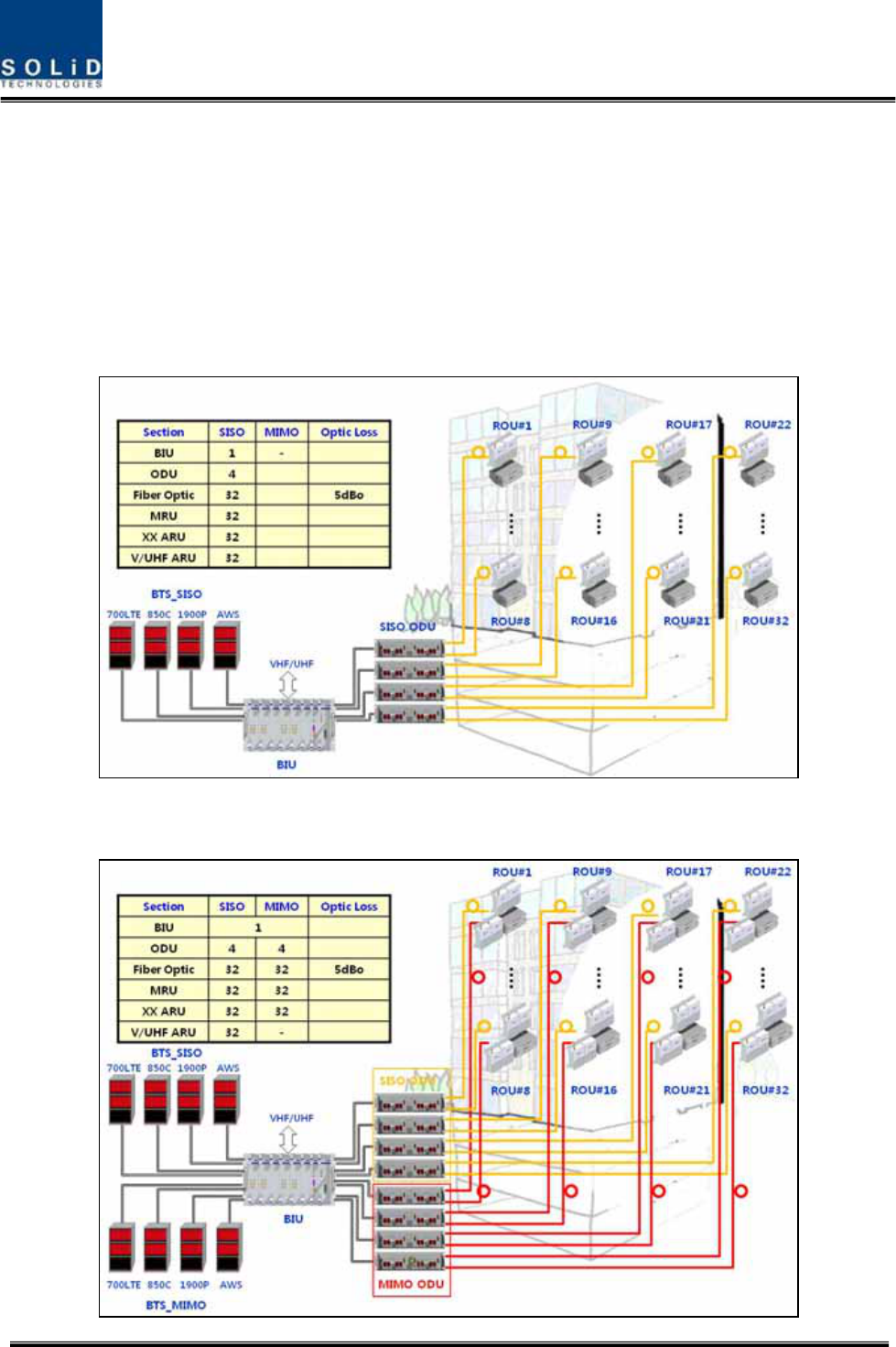
Confidential & Proprietary 15/116 SC-DAS
2.2 System overview
SC-DAS is composed of devices given below.
Basically, the system consists of BIU (BTS Interfcace Unit), ODU (Optic distribution Unit) and ROU
(Remote Optic Unit). For addition of more ROUs, it has OEU (Optic Expansion Unit).
BIU has two layer which supports both SISO and MIMO configuration using separate optical fiber
cable. Fig2.1 shows basic system topology for SISO
Figure 2.1 – Basic system topology supporting SISO configuration

Confidential & Proprietary 16/116 SC-DAS
Figure 2.2 – Basic system topology supporting MIMO configuration
As shown at Fig2.1 and 2.2, one optical cable needs for SISO configuration but two optical cable
needs for MIMO cofiguration when it connected with ROU. A site requirement for a SISO application
even though more optical cable needs, we can expand more ROUs using MIMO slot up to 64 ROUs
Without addtive BIU for expanding MIMO, it supports both SISO and MIMO configuration usign one
BIU. For configuration of MIMO, it needs ODUs for MIMO path only.
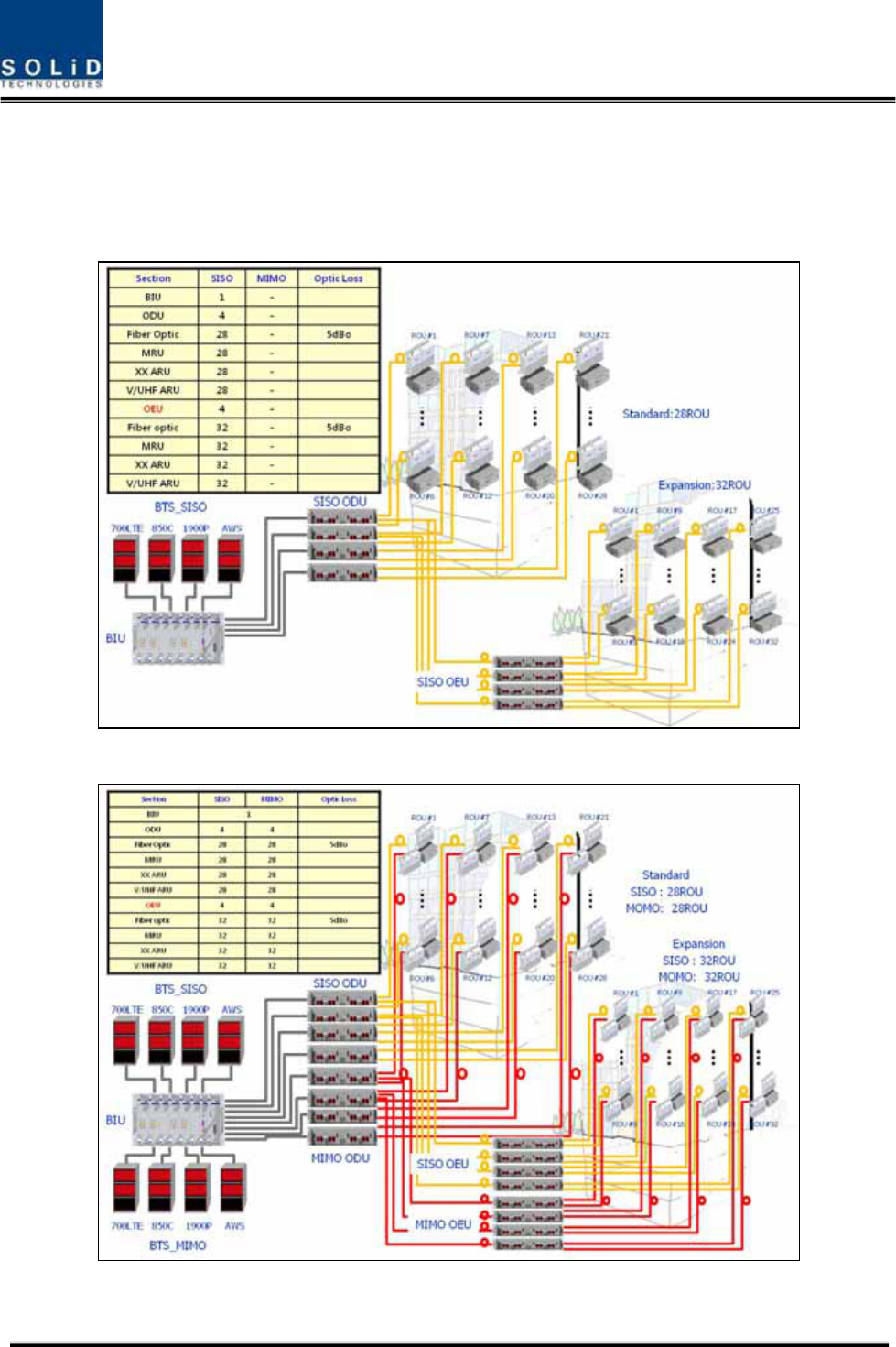
Confidential & Proprietary 17/116 SC-DAS
To reduce number of optical cables between building or support campus cluster application, we can
utilize the OEU(Optical Expansion Unit)
Fig 2.3 shows expansion system topology supporting SISO configuration using OEU
Figure 2.3 – Expansion system topology supporting SISO configuration
Figure 2.4 – Expansion system topology supporting MIMO configuration

Confidential & Proprietary 18/116 SC-DAS
Fig 2.4 shows expansion system topology supporting MIMO configuration using OEU
Section3
System Specifications
3.1 System specifications
3.1.1 Physical Specifications
3.1.2 Optic wavelength and Laser power
3.1.3 Environmental specifications
3.1.4 Operating Frequencies range
3.1.5 Specifications Per band

Confidential & Proprietary 19/116 SC-DAS
3.1 System specifications
3.1.1 Physical Specifications
Parameter BIU ODU OEU MRU ARU
RF Connectors 4 SMA pairs(TX,RX)
per MDBU 2 SMA -
1 N-type
2SMA :optical
2SMA :RF
2SMA :optical
2SMA :RF
External Alarm
connector
(Dry contacts)
TB: 4pcs for output
TB: 3pcs for input - - - -
Serial Interface
connector 1 USB(B) type 1 USB(B) type 1 USB(B) type 1 USB(B) type
Fiber connector - 8pcs, SC/APC for
ROU
1 SC/APC for ODU
8 SC/APC for ROU 1 SC/APC for ODU -
LED Alarm and
Status Indicator
MDBU Status
z Power status
z ALM status
MCPU
z Power status
z TX Comm
z RX Comm
z ALM status
MPSU
z Power status
z DC ALM status
DOU1 Status
z LD status
z PD1/2/3/4
status
DOU2 Status
z LD status
z PD1/2/3/4
status
EWDM Status
z LD status
z PD status
DOU1 Status
z LD status
z PD1/2/3/4
status
DOU2 Status
z LD status
z PD1/2/3/4
status
System status
z Power status
z TX1 Comm
z RX1 Comm
z TX2 Comm
z RX2 Comm
z ALM status
System status
z Power status
z TX Comm
z RX Comm
z ALM status
z Opt status
System status
z Power status
z TX Comm
z RX Comm
z ALM status
AC Power - -
Normal Range: 120VAC
50/60Hz
Operating range
108~132VAC,50/60Hz
Same left side
DC Power
Normal range: -48
VDC
Operating range:
-40.8 ~ -57.6VDC
Be provided by BIU
Normal: -48 VDC
Operating range:
-40.8 ~ -57.6VDC
Same to left side
Power
consumption
SISO Mode : 162W
(Including SISO ODU
4EA)
MIMO Mode : 315W
(Including SISO ODU
4EA+MIMO ODU 4EA)
28W
(Including DOU2EA)
40W
(Including DOU2EA) 50W for dual band 40W for dual band
Enclosure
Dimensions
482.6(19”) x
221.5(5U) x 450
482.6(19”) x
43.6(1U) x 450
482.6(19”)
x 88.1(2U) x 450 300 x 200 x 258 300 x 200 x 258
Weight[Full Load] 26.2Kg 6Kg 9.6Kg 6.6Kg 6.8Kg

Confidential & Proprietary 20/116 SC-DAS
3.1.2 Optical wavelength and Laser power
Parameter ODU OEU ROU
Optical Wavelength
TX: 1310nm
RX: 1550nm
West optic
TX: 1550nm, RX: 1310nm
East optic
TX: 1310nm, RX: 1550nm
TX: 1550nm
RX: 1310nm
Output power 1.5dBm±1dBm to ROU,OEU
1dBm±1dBm to ROU
7dBm±1dBm to ODU
7dBm±1dBm to ODU
Return loss <45dB <45dB <45dB
3.1.3 Environmental specifications
Parameter BIU, ODU, OEU ROU/AOR
Operating Temperature -10 to +50°C -10 to +50°C
Operating Humidity, non condensing - 5% to 90%
3.1.4 Operating Frequencies range
Frequency range
Standard Unit naming Description
TX(MHz) RX(MHz)
iDEN 700PS Public safety 764 to 776 794 to 806
iDEN 800PS Public safety 851 to 869 806 to 824
Cellular 850C Cellular 869 to 894 824 to 849
iDEN 900I SMR 929 to 940 896 to 902
Paging 900 PA Paging 929 to 930 896 to 902
PCS 1900P PCS 1930 to 1995 1850 to 1915
AWS-1 AWS-1 AWS-1 2110 to 2155 1710 to 1755
- VHF Public safety 136 to 174 136 to 174
- Public safety(Band1)
396 to 450
450 to 512
396 to 450
450 to 512
UHF
Public safety(Band2)
380 to 434
434 to 496
380 to 434
434 to 496
LTE 700LTE Long Term Evolution 728 to 756
698 to 716
777 to 787

Confidential & Proprietary 21/116 SC-DAS
3.1.5 Specifications Per band
SC-DAS has a lot of band combination as application and different output power even
though same band uses. TableXX shows Output power level as follow band combination
1) Output power level
Band Combinations
MRU ARU
700PS 700LTE 800PS/I 850C 900I 1900P AWS VHF UHF
1900P+850C 700LTE+AWS - 24dBm - 24dBm - 28dBm 28dBm
1900P+AWS - - - - - - 30dBm 30dBm
1900P 900I+800I - - 25dBm - 25dBm 30dBm -
1900P - - - - - - 30dBm -
1900P+850C 700PS+800PS 21dBm - 21dBm 21dBm - 30dBm -
700PS+800PS 900I+800I 21dBm - 21dBm 21dBm - -
24dBm 24dBm
2) General Specifications
Parameter Specifications Remark
TX 25dB/step 1dB ROU
Gain Control range
RX 20dB/step 1dB BIU
TX input power -20dBm~+10dBm
Spurious Emission < -13dBm
Optical Link AGC >10dB
VSWR 1.8:1
Pass-band Ripple 4dBp-p
Max optical Loss 5dBo
Optical wavelength 1310nm/1550nm with WDM
RX output power 0dBm
RX input power -50dBm Max
Noise Figure < 8dB
Excluding 700PS,
800PS

Confidential & Proprietary 22/116 SC-DAS
Section4
System Configuration and Functions
4.1 BIU (BTS Interface Unit)
4.2 ODU (Optic distribution Unit)
4.3 OEU (Optic Expansion Unit
4.4 ROU (Remote Optic Unit)
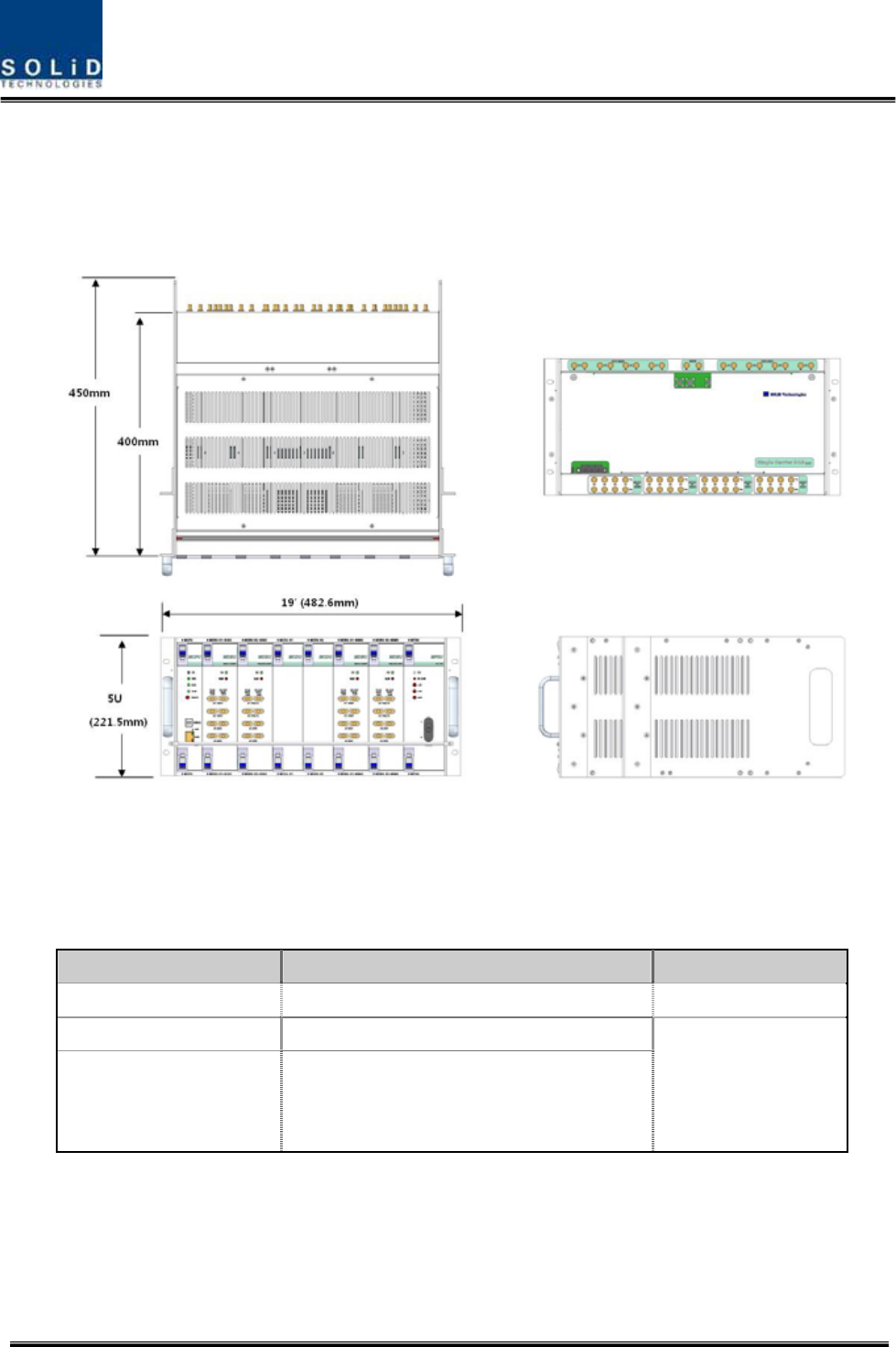
Confidential & Proprietary 23/116 SC-DAS
4.1 BIU (BTS Interface Unit)
BIU is provided signals from BTS or BDA through coaxial cable and transmit it to four ODUs
(Optic Distribution Unit).and This unit separates RX signals given from ODUs from each
other per frequency band.
Figure 4.1 – BIU outer view
4.1.1 Specifications of BIU
Item Spec. Remark
Size 482.6(19”) x 221.5(5U) x 450 mm
Weight 26 Kg
Power consumption
SISO Mode : 168 W(Including SISO ODU 4EA)
MIMO Mode : 315W(Including SISO ODU
4EA+MIMO ODU 4EA)
Full Load
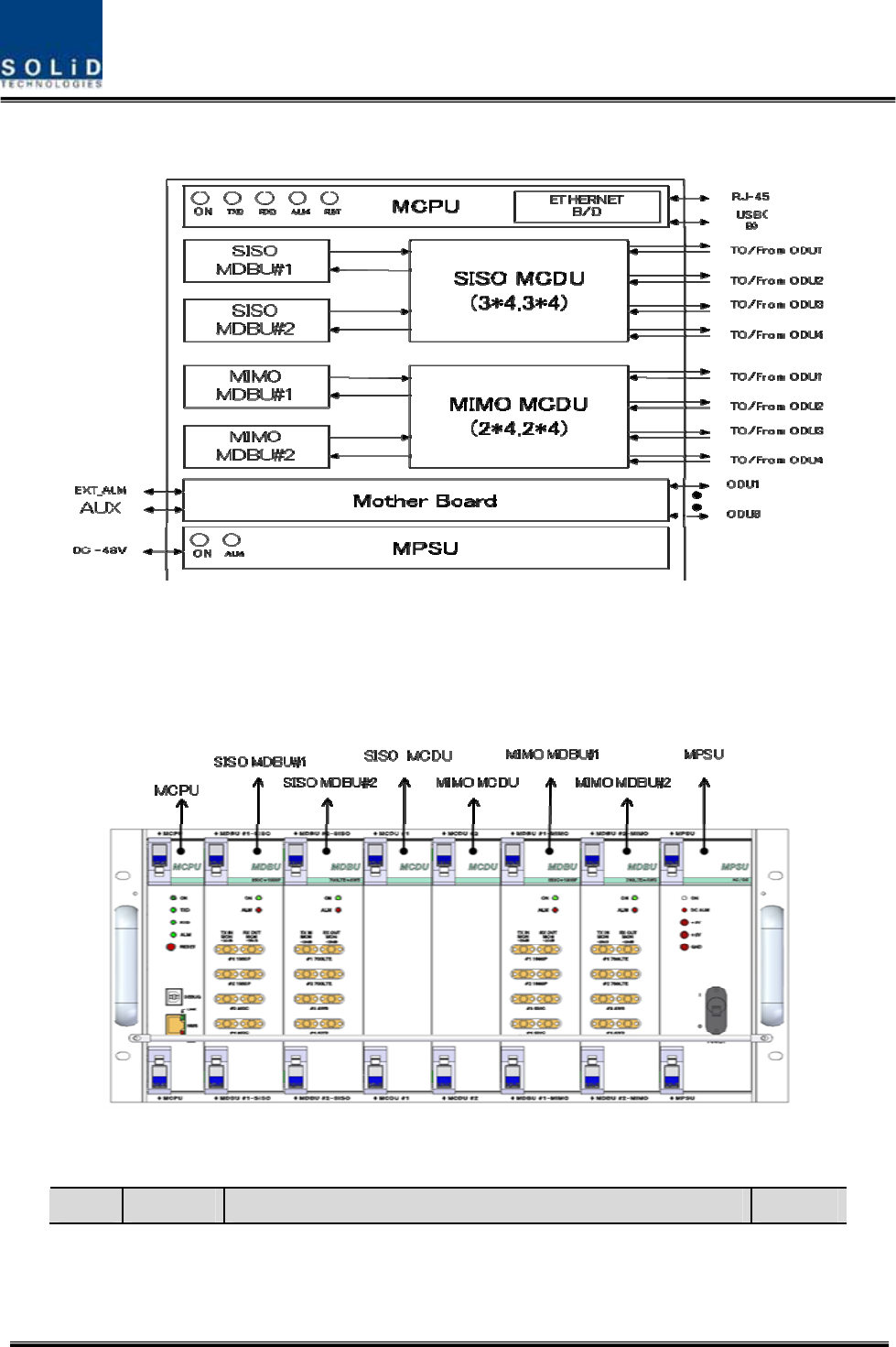
Confidential & Proprietary 24/116 SC-DAS
4.1.2 Block diagram of BIU
Figure 4.2 – BIU block diagram
4.1.3 BIU parts
Figure 4.3 – BIU mounting diagram
No. Unit Description Remark

Confidential & Proprietary 25/116 SC-DAS
1 MDBU
Main Drive BTS Unit
Amplify & adjust downlink RF signal
Amplify & adjust uplink RF signal
Max 4EA
2 MCDU
Main Com/Div Unit
Combine 3EA downlink signal and divide 4EA signal to ODU
Combine 4EA uplink signal and divide 3EA signal to MDBU
Support VHF/UHF interface port
3 MCPU
Main Central Processor Unit
Control and monitoring system status
Control and monitoring with USB(B)
Have an access to upper-level network through GSM or Ethernet
4 MPSU Main Power Supply Unit
Input power: DC -48V, Output power: 9V, 6V
5 M/B
Mother Board
Provide signal interface and power for each unit
Provide four ports for dry contact output
Provide three ports for input
Provide two Aux ports for future usage
6 Shelf 19 inch, 5U
4.1.4 Function by unit
1) Main Drive BTS Unit (MDBU)
MDBU delivers TX signals of BTS or BDA to related devices and then delivers RX signals of the
devices to BTS or BDA. This unit can monitor TX input level. Using input AGC function, it
automatically adjusts input ATT according to input power. It also has ATT to adjust RX gain. MDBU is
varied per frequency band including the following:
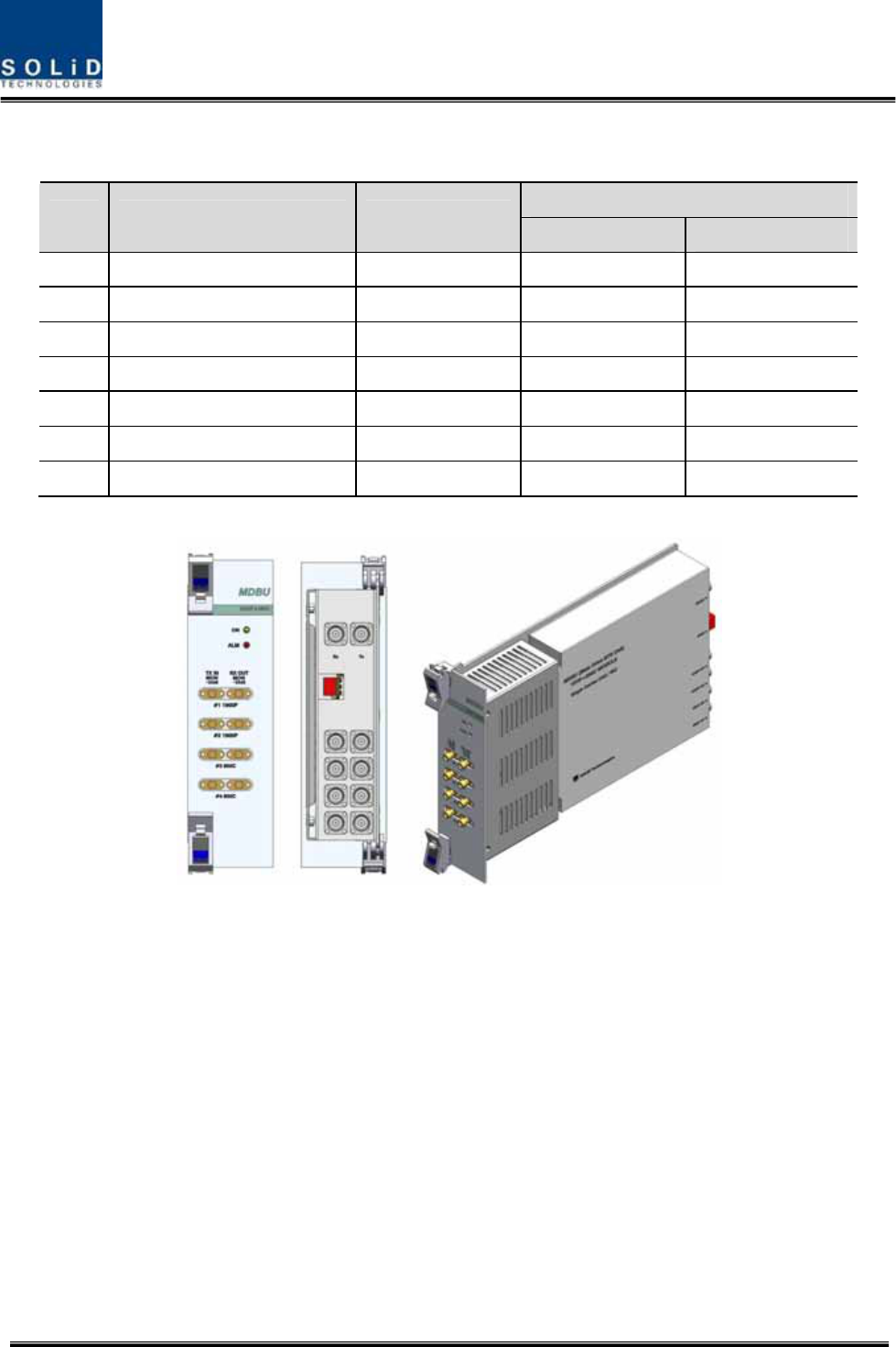
Confidential & Proprietary 26/116 SC-DAS
In/out RF Port
No Unit naming Description
TX RX
1 1900P+850C Dual Band 4 Port 4 Port
2 700LTE+AWS-1 Dual Band 4 Port 4 Port
3 1900P Single Band 2 Port 2 Port
4 1900P+AWS-1 Dual Band 4 Port 4 Port
5 700PS+800PS Dual Band 4 Port 4 Port
6 900I+800I Dual Band 4 Port 4 Port
7 900I Dual Band 2 Port 2 Port
Figure 4.4 – MDBU Outer Look
2) Main Com/Div Unit (MCDU)
MCDU combines TX signals that are delivered from MDBU per frequency band and delivers the
signals to four ODUs. It also combines RX signals from up to four ODUs and sends them to up to four
MDBUs.The unit has a port to interface with VHF&UHF signals. It has ATT for input monitoring and
input control.
The unit has reserved port for future usage such as LMU interface, additive MDBU interface and so
on
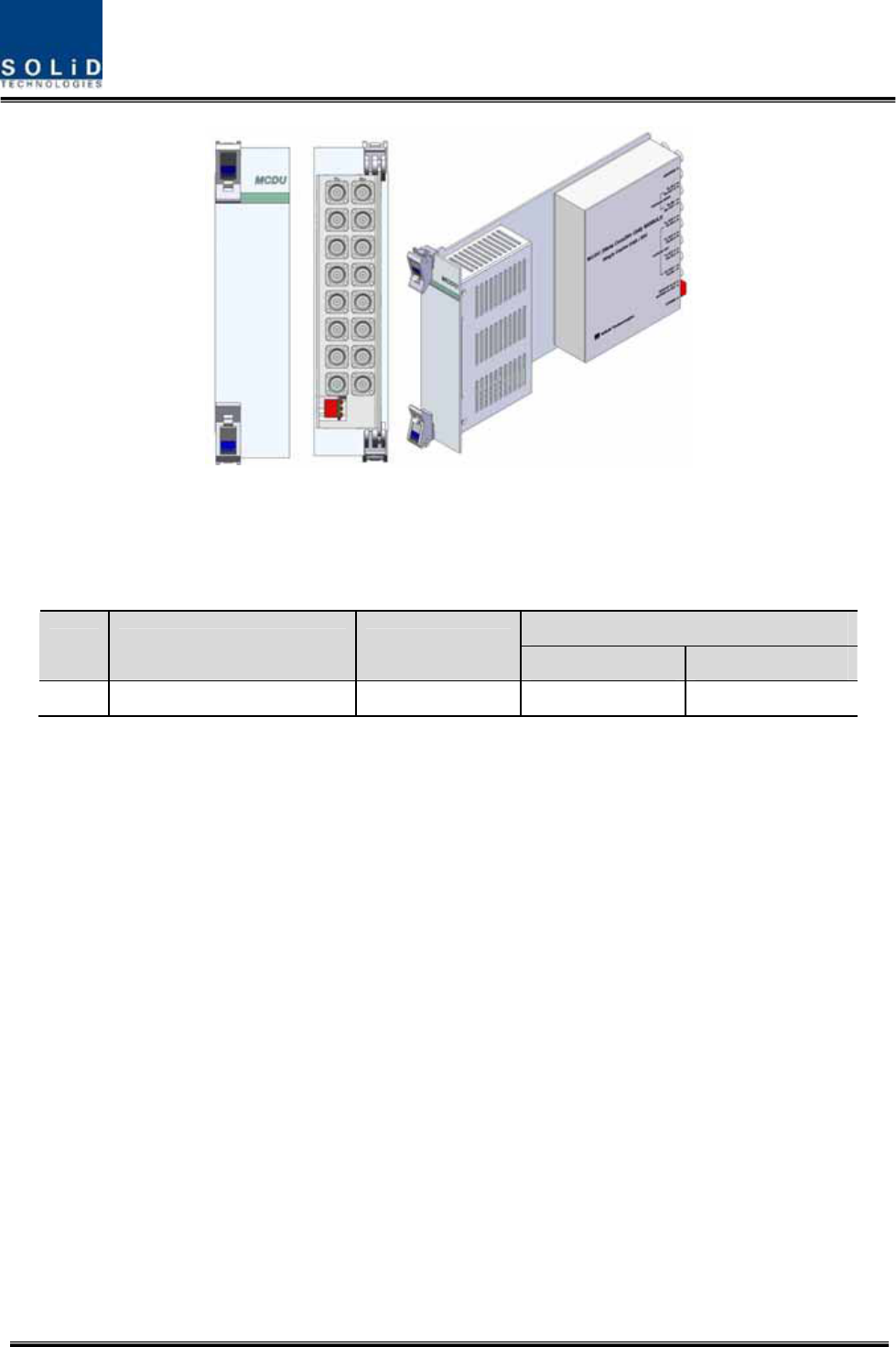
Confidential & Proprietary 27/116 SC-DAS
Figure 4.5 – MCDU Outer Look
VHF+UHF frequency band including the following:
In/out RF Port
No Unit naming Description
TX RX
1 VHF+UHF Dual Band 1 Port 1 Port
3) Main Central Processor Unit (MCPU)
MCPU can inquire and control state of modules that are installed in BIU.
This unit can inquire and control state of four ODUs in total. Through communication, it also can
inquire and control ROU that is connected with lower parts.
In addition, the unit has USB(B) port for local monitoring so that it can inquire and control state of
devices through PC. On the front panel, it has communication LED indicator to check communication
state with ROU. It also has ALM LED indicator to show whether a device gets faulty.
For access to upper network, it has a port to insert Ethernet port and GSM modem in it.
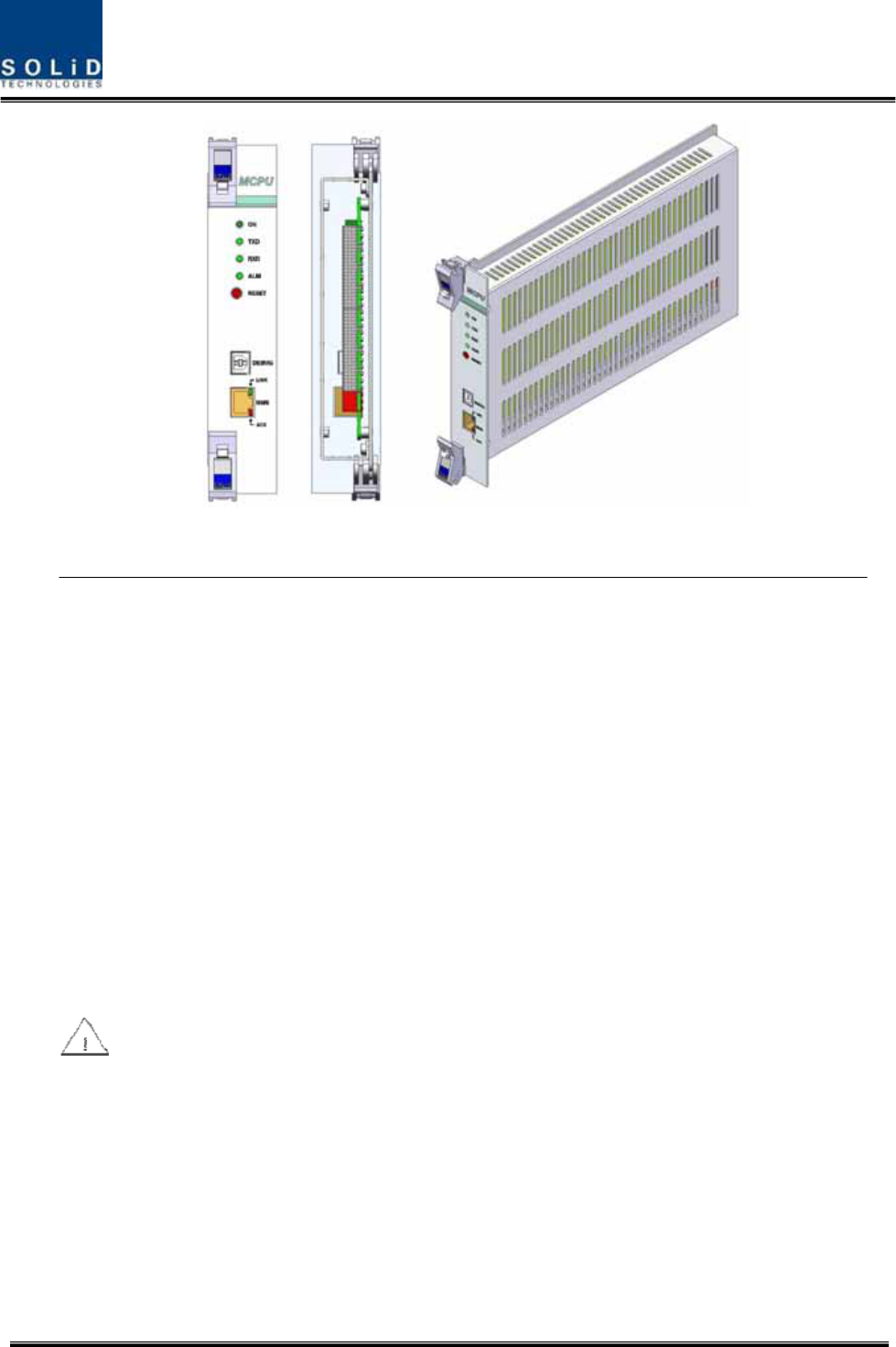
Confidential & Proprietary 28/116 SC-DAS
Figure 4.6 – MCPU Outer Look
In the Main Central Processor Unit, a lithium battery is installed for RTC (Real Time Control) function.
CAUTION
RISK OF EXPLOSION IF BATTERY IS REPLACED BY AN INCORRECT TYPE
DIPOSE OF USED BATTERIES ACCORDING TO THE INSTRUCTIONS
[INSTRUCTION]
The equipment and accessories including inner lithium battery are to be disposed of safely after the
life span of them and national regulation must be observed. Do not attempt to replace the lithium
battery unless service personnel confirmation has first been obtained, to avoid any risk of explosion.
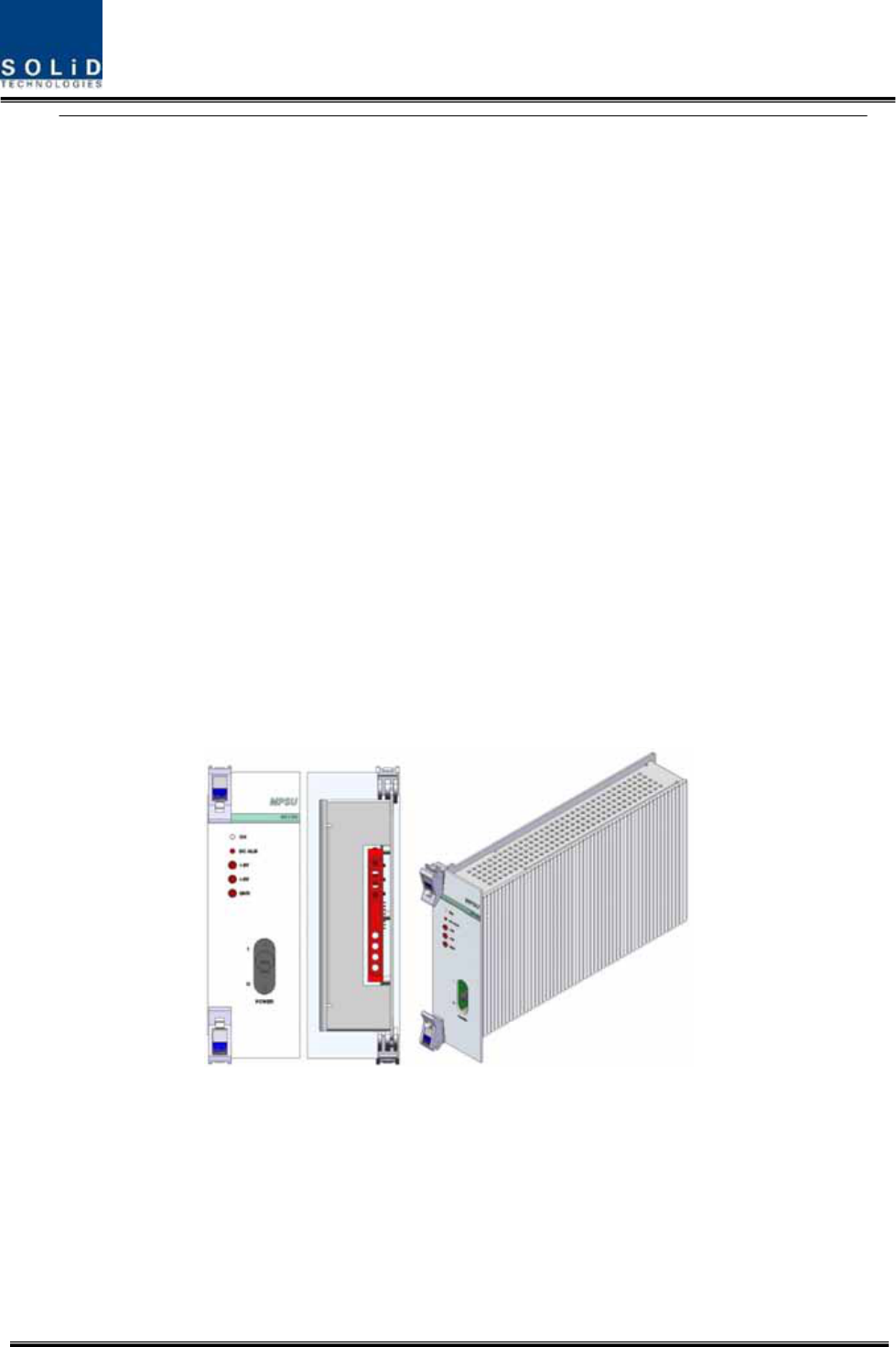
Confidential & Proprietary 29/116 SC-DAS
4) Main Power Supply Unit (MPSU)
MPSU receives -48V of input and outputs +6V and +9V of DC power.
On the front panel, this unit has an output test port and it also has DC ALM LED Indicator to show
whether output gets faulty.
Figure 4.7 – MPSU Outer Look
4.1.5 Front/Rear panels of BIU
1) Front panel

Confidential & Proprietary 30/116 SC-DAS
Figure 4.8 – BIU front panel Outer Look
Item Description
1. Alarm LED & Reset Communication state with devices, alarm status of the system and reset
switch
2. DEBUG (USB B)
USB port for communication and diagnosis of devices through PC/laptop
This equipment is indoor use and all the communication wirings are limited to
inside of the building
3. NMS(Ethernet port) Ethernet port for upper network
The supporting network mode is UDP protocol
4. MDBU LED LED to show whether MDBU is installed and gets faulty
5. RF Monitor Port 20dB Coupling compared with TX Input Level
20dB Coupling compared with RX Output Level
6. Pwr Test Port & ALM Output DC power test port and ALM LED to show abnormal state, if any
7. Power switch Power ON/OFF switch
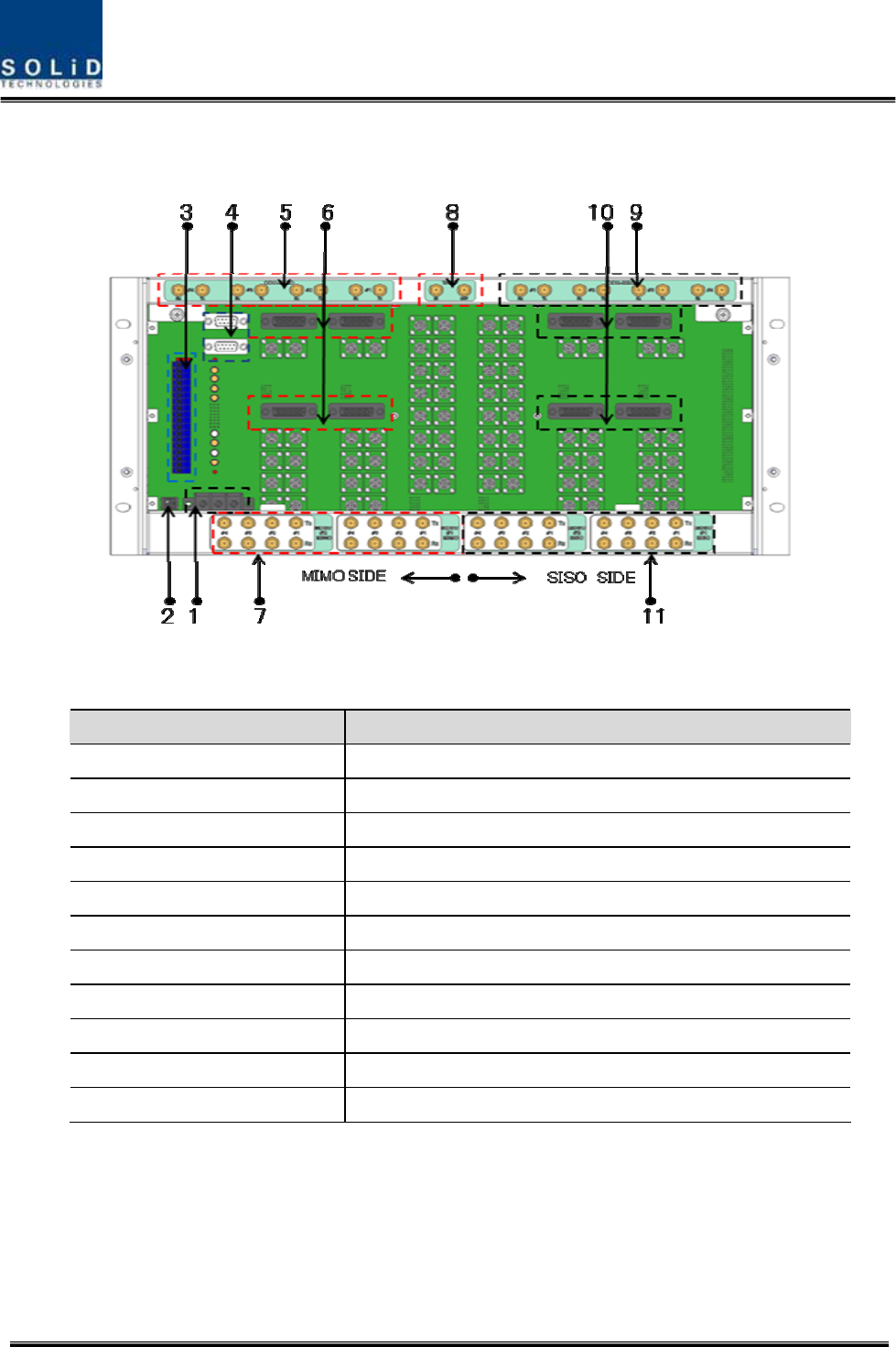
Confidential & Proprietary 31/116 SC-DAS
2) Rear panel
Figure 4.9 – Rear panel Outer Look
Item Description
1. DC Input Port Input terminal for DC -48V
2. External ALM Port Input/output terminal for dry contact
3. GND Port System ground terminal
4. AUX I/O Port Reserved Port for future uses
5. MIMO ODU I/O Port RF signal interface terminal for ODU
6. MIMO ODU signal Port Power and signal interface terminal for ODU
7. MIMO BTS/BDA I/O Port Input/output interface terminal of BTS/BDA
8. V/UHF I/O Port RF signal interface terminal of VHF&UHF
9. SISO ODU I/O Port RF signal interface terminal for ODU
10. SISO ODU signal Port Power and signal interface terminal for ODU
11. SISO BTS/BDA I/O Port Input/output interface terminal of BTS/BDA
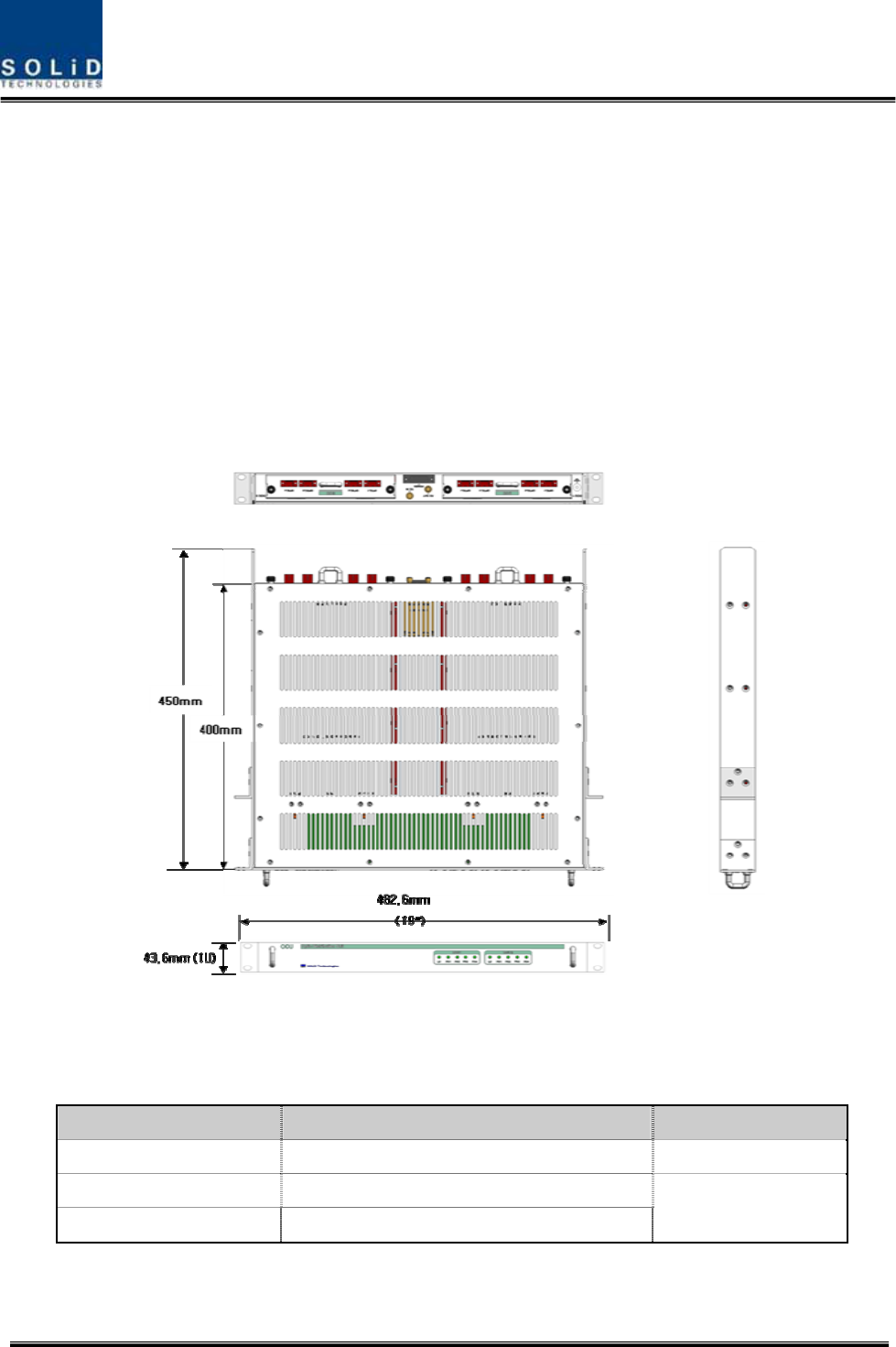
Confidential & Proprietary 32/116 SC-DAS
4.2 ODU (Optic distribution Unit)
ODU receives TX RF signals from upper BIU and converts them into optical signals. The optical
signals are sent to ROU through optical cables. This unit converts optical signals from ROU into RF
signals and sends the converted signals to BIU.
For each shelf of the ODU, up to two DOUs (Donor Optic Unit) can be installed in it.
One DOU is supported with four optical ports. Therefore, one ODU can be connected with eight
ROUs.
Up to four ODUs can be connected with BIU each SISO and MIMO path
Figure 4.10 – ODU Outer Look
4.2.1 Specifications of ODU
Item Spec. Remark
Size 482.6(19”) x 43.6(1U) x 450 Mm
Weight 6 Kg
Power consumption 27 W Full Load
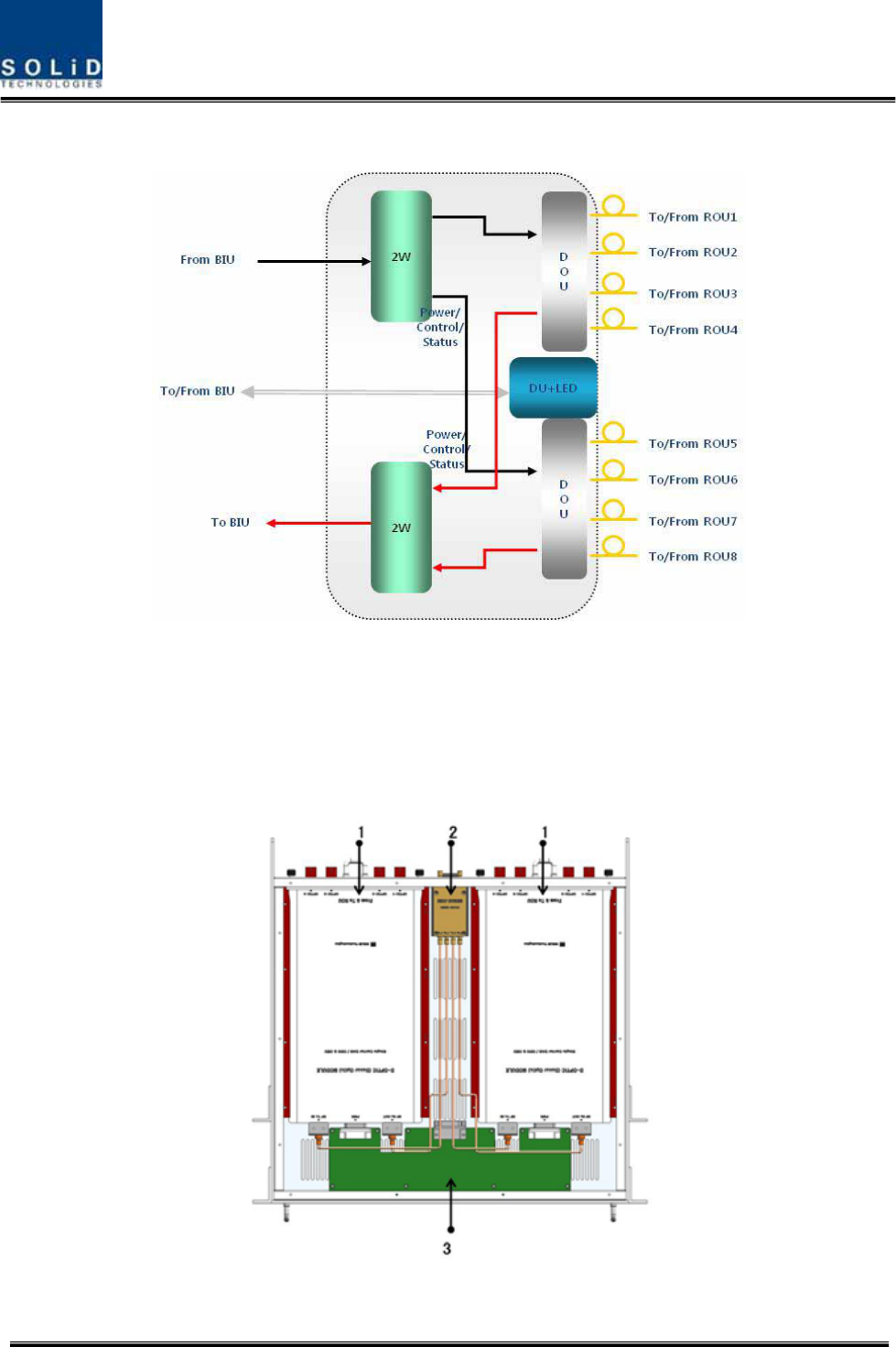
Confidential & Proprietary 33/116 SC-DAS
4.2.2 Block Diagram of ODU
Figure 4.11 – ODU block diagram
4.2.3 ODU parts
Figure 4.12 – ODU Inner Look

Confidential & Proprietary 34/116 SC-DAS
No. Unit Description Remark
1 DOU
Donor Optic Unit
Convert TX RF signals into optical signals;
Convert RX optical signals into RF signals;
Provide up to four optical ports per DOU
Max 2ea
2 2W
2Way Divider
Divide TX RF signals into two;
Combine two RX RF signals into one
3 DU Distribution Unit
Distribute power and signals to DOU
4 Shelf 19” rack, 1U
5 Accessories 25PIN DSUB, Male to female 1pcs
RF Coaxial Cable Assembly 2pcs
4.2.4 Function by unit
1) Donor Optic Unit (DOU)
DOU operates electronic-optical conversion of TX signals and operates optical-electronic conversion
of RX signals.
With an optic splitter in it, this unit divides optical signals from Laser Diode into four and then
distributes them to each optical port. With a total of four Photo Diodes in RX, DOU makes optical-
electronic conversion of signals received from each optical port. In addition, the unit is equipped with
ATT for optical compensation made in case of optical cable loss.
With internal WDM, it uses only one optical cable to be connected with ROU
With internal FSK modem, it can be operated automatical ID allocation.
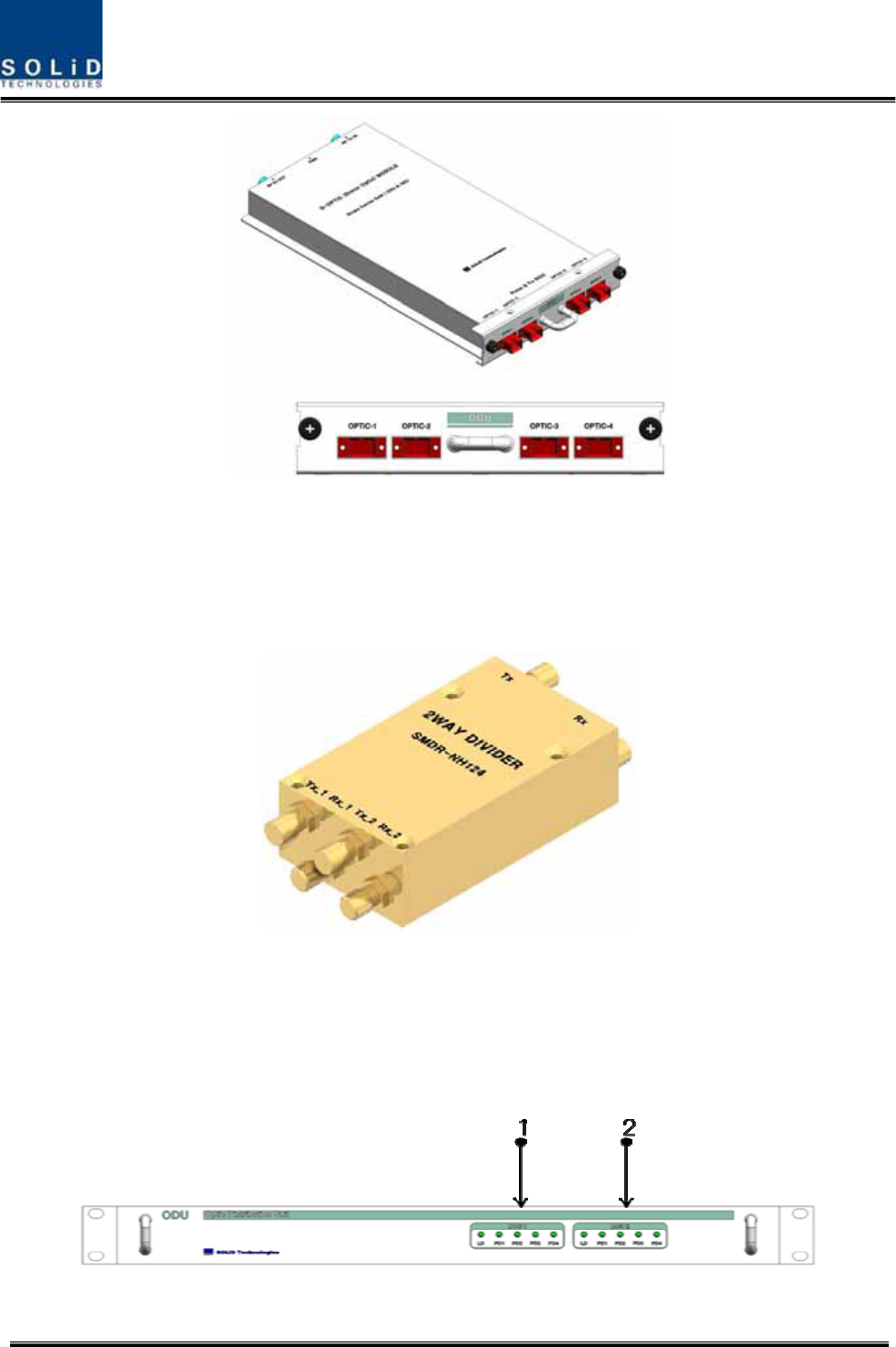
Confidential & Proprietary 35/116 SC-DAS
Figure 4.13 – DOU Outer Look
2) 2Way Divider (2W)
2W is equipped with two 2-way splitters in a one-module form and the splitters work for TX/RX
signals, respectively.
Designed in broadband type, the divider combines and divides signals from/to BIU
Figure 4.14 – 2Way Divider Outer Look
4.2.5 Front/rear panels of ODU
1) Front panel
Figure 4.15 – ODU front panel Outer Look
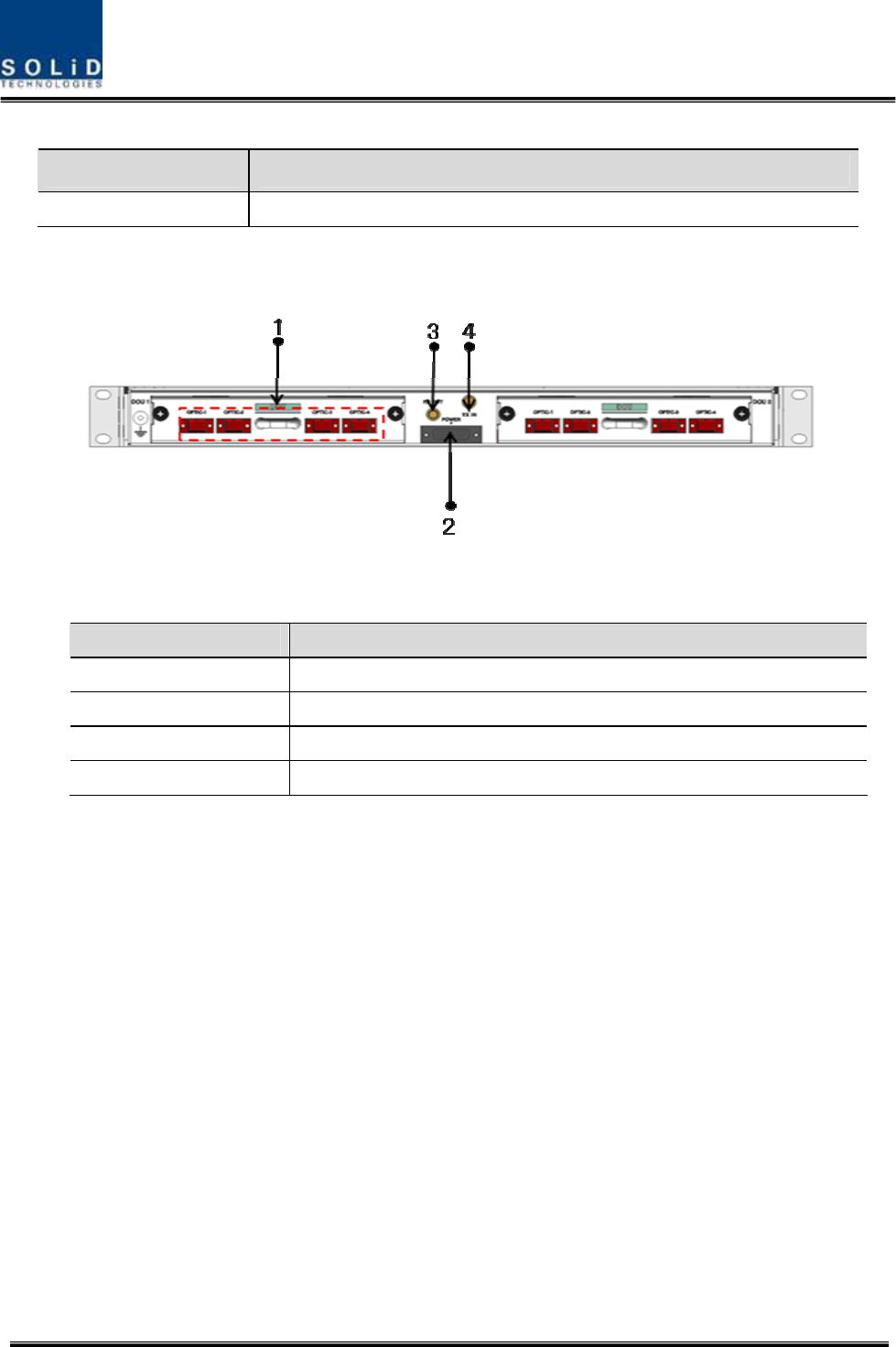
Confidential & Proprietary 36/116 SC-DAS
Item Description
1,2 LED indicator to check DOU module state to see if it is abnormal
2) Rear panel
Figure 4.16 – ODU Rear panel Outer Look
Item Description
1. Optic Port SC/APC optical connector terminal; use one optical cable per ROU.
2. DC I/O Port Terminal to deliver power and state values
3. RX RF Port RX RF signal interface terminal
4. TX RF Port TX RF signal interface terminal
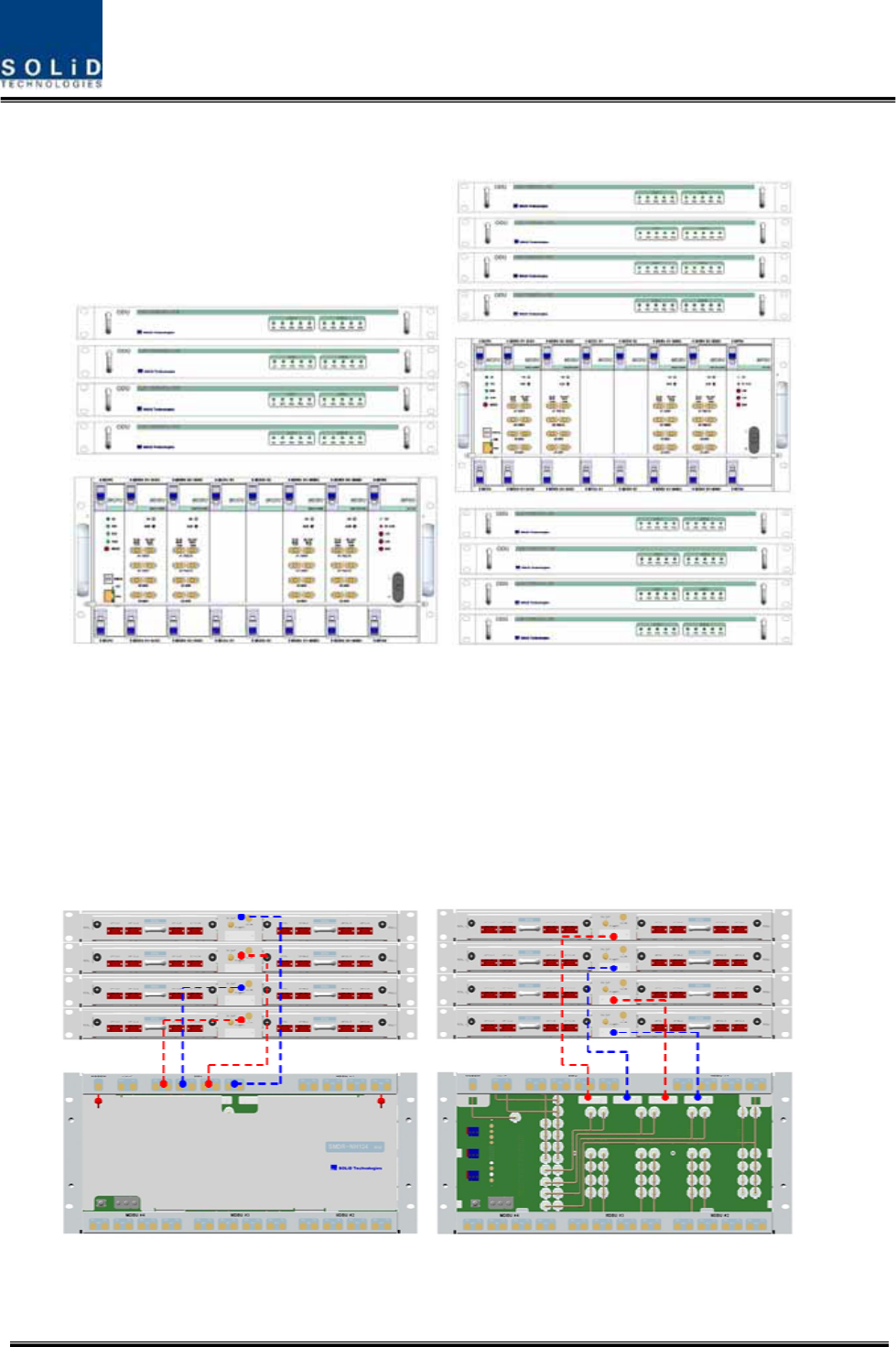
Confidential & Proprietary 37/116 SC-DAS
4.2.6 Interface with BIU
SISO Configuration MIMO Configuration
Figure 4.17 – Interface between BIU and ODU
For SISO configuration, up to four ODUs can be stacked. above the top of BIU
For MIMO configuaration, up to eight ODUs can be stacked above/below BIU
In this case, it is recommended to stack the units at least 1U of an interval between BIU, for heat
from BIU may climb up to ODU, which may cause degration of equipment
Figure 4.18 – Interface between BIU and ODU at the back
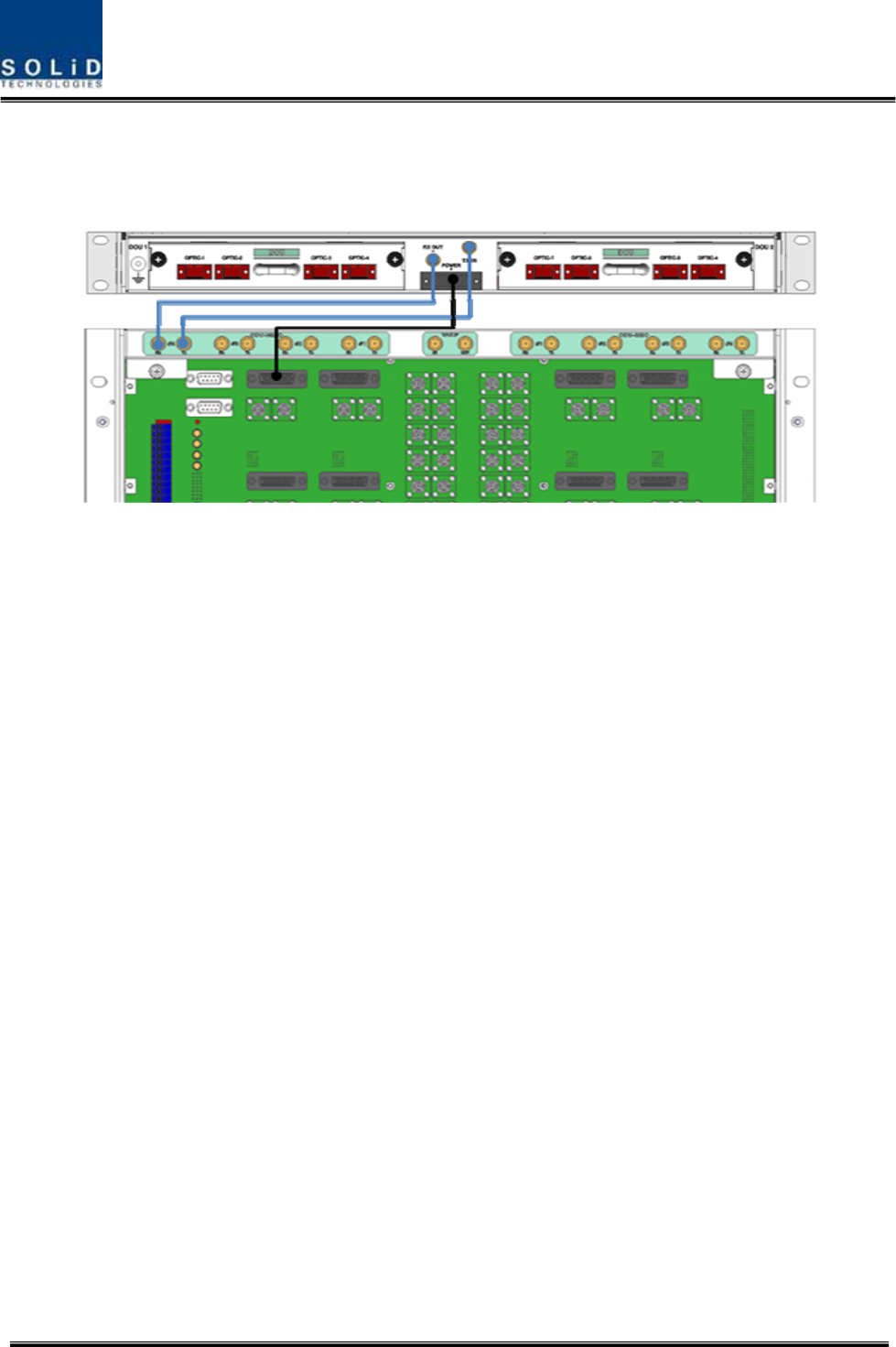
Confidential & Proprietary 38/116 SC-DAS
As seen in the figure below, connect the coaxial cable for TX and another coaxial cable for RX with
corresponding ports at the rear of BIU. For power supply and communication, connect 25Pin D-Sub
Connector cable with a corresponding port.
Figure 4.19 – Interface between BIU and ODU more detail
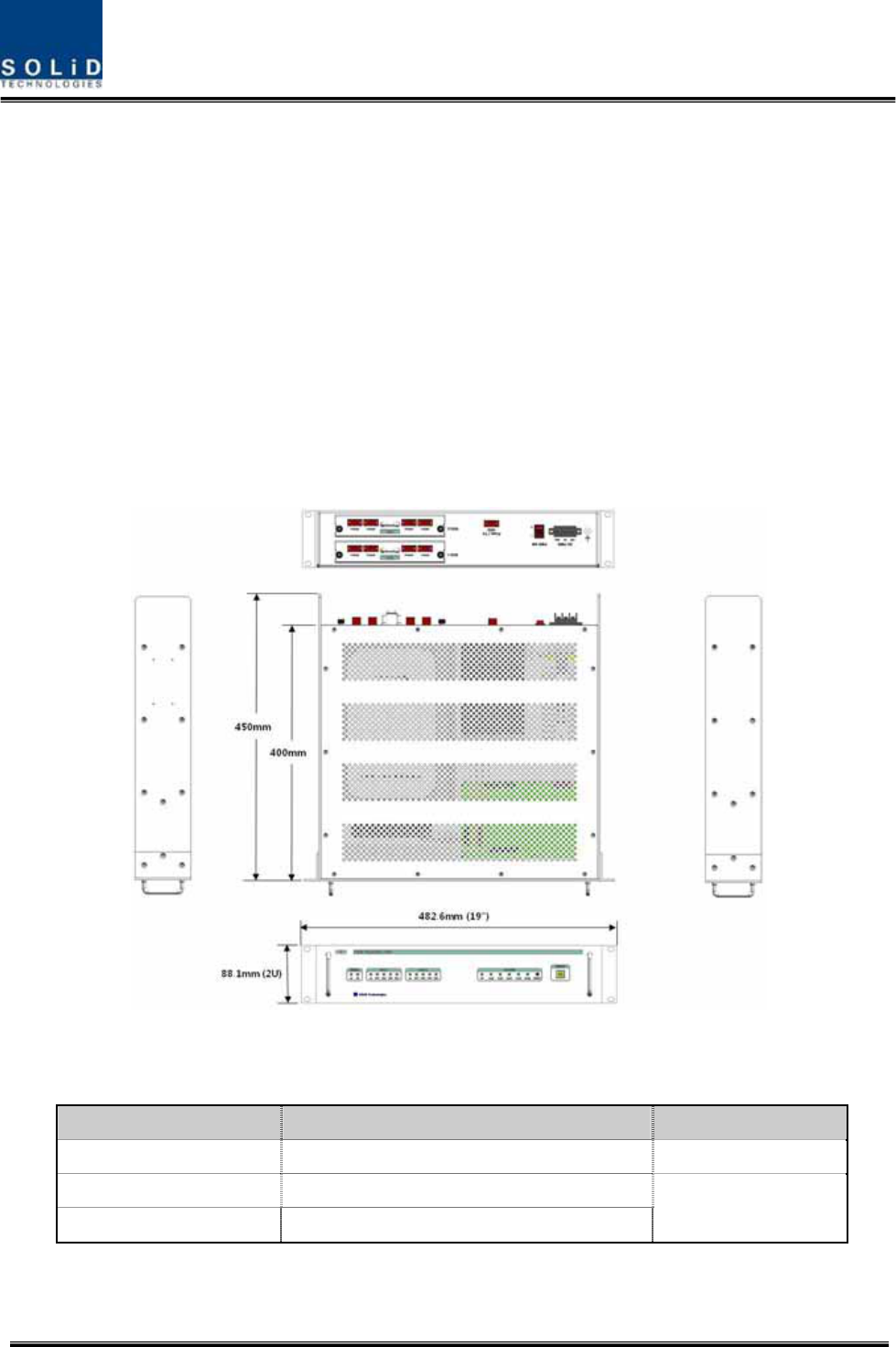
Confidential & Proprietary 39/116 SC-DAS
4.3 OEU (Optic Expansion Unit)
OEU is mainly used to remotely deliver signals for Campus clusters. At the upper part, this unit
combines with ODU and receives TX optical signals to convert them into RF signals. Then, it
regenerates the signals to secure SNR and converts them into optical signals. The signals are sent to
ROU through optical cables. When it receives RX optical signals from ROU, the unit converts them
into RF signals to regenerate the signals and then converts them into optical signals to send them to
ODU.
In OEU, one shelf can be equipped with up to two DOUs. The DOU is the same as the module used
for ODU. Up to four OEUs can be connected with ODU.
Figure 4.20 – OEU Outer Look
4.3.1 Specifications of OEU
Item Spec. Remark
Size 482.6(19”) x 88.1(2U) x 450 mm
Weight 9.5 Kg
Power consumption 40 W Full Load
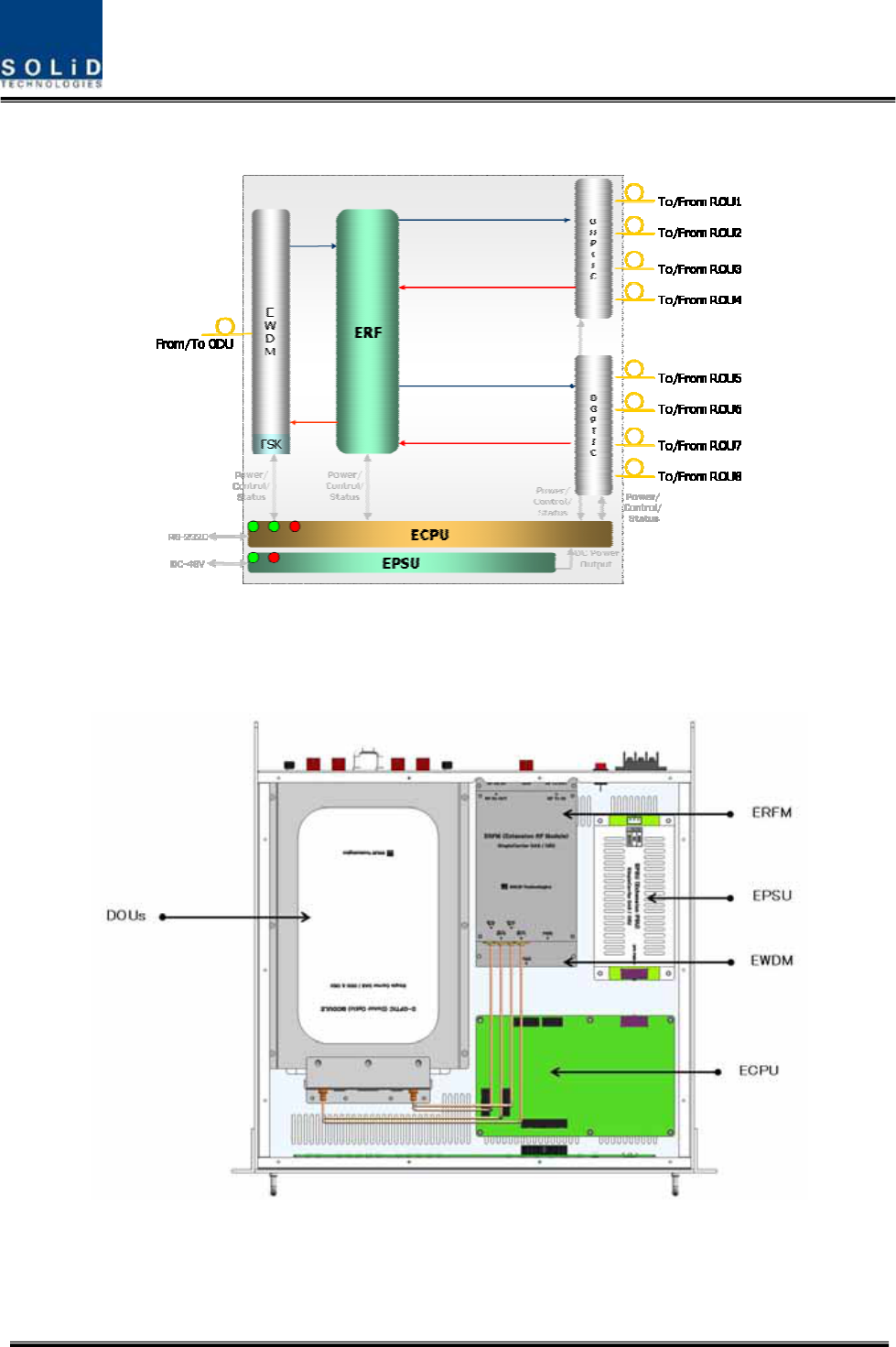
Confidential & Proprietary 40/116 SC-DAS
4.3.2 Block Diagram of OEU
Figure 4.21 – OEU block diagram
4.3.3 OEU parts
Figure 4.22 – OEU Inner Look

Confidential & Proprietary 41/116 SC-DAS
No. Unit Description Remark
1 DOU
Donor Optic Unit
Convert TX RF signals into optical signals;
Convert RX optical signals into RF signals;
Provide up to four optical ports per DOU
Max 2ea
2 EWDM
Expansion Wavelength Division Multiplexer
Convert TX optical signals into RF signals;
Convert RX RF signals into optical signals;
Compensate for optical cable loss with ODU
3 ECPU
Expansion Central Processor Unit
Control and monitoring system status
Control and monitoring with RS232
Relay state values of ROU to BIU
4 EPSU Expansion Power Supply Unit
Input power: DC -48V, Output power: 9V, 6V
5 ERFM
Expansion Radio Frequency Module
Regenerate TX signals and transmit FSK modem signals;
Regenerate RX signals and receive FSK modem signals
6 Shelf 19” rack, 2U
4.3.4 Function by unit
1) Donor Optic Unit (DOU)
DOU is the same as the module used for ODU.
Figure 4.23 – DOU Outer Look
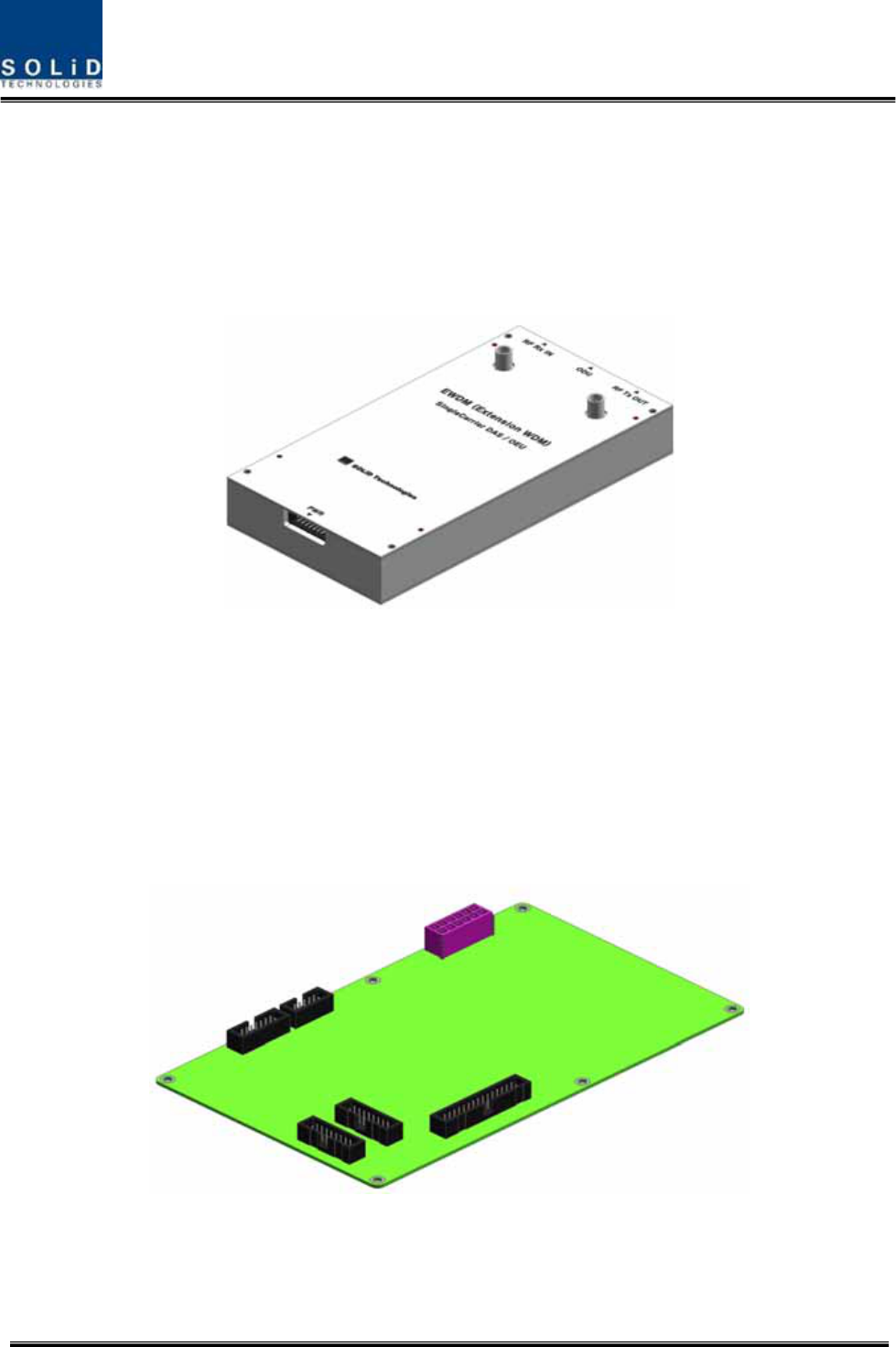
Confidential & Proprietary 42/116 SC-DAS
2) Expansion Wavelength Division Multiplexer(EWDM)
EWDM module makes optical-electronic conversion of TX signals and makes electronic-optical
conversion of RX signals. With an FSK modem in it, this multiplexer communicates with BIU. It also
has ATT for optical compensation to compensate for optical cable loss between ODUs.
Furthermore, it has internal WDM, and so, it needs only one optical cable to work with ROU.
Figure 4.24 – EWDM Outer Look
3) Expansion Central Processor Unit(ECPU)
ECPU can inquire and control state of modules to be installed into OEU. This unit communicates with
upper BIU while communicating with lower ROU. It also acts as communication bridge between BIU
and ROU.
In addition, the unit has USB port for local communication, which enables inquiry and control of
devices thorugh PC. At the front panel, communication LED indicator indicates communication state
with upper BIU and lower ROU. It also has ALM LED indicator to show if a device gets faulty.
Figure 4.25 – ECPU Outer Look
4) Expansion Radio Frequency Module(ERFM)
ERFM reconstructs Signal to Noise degraded by optical modules.
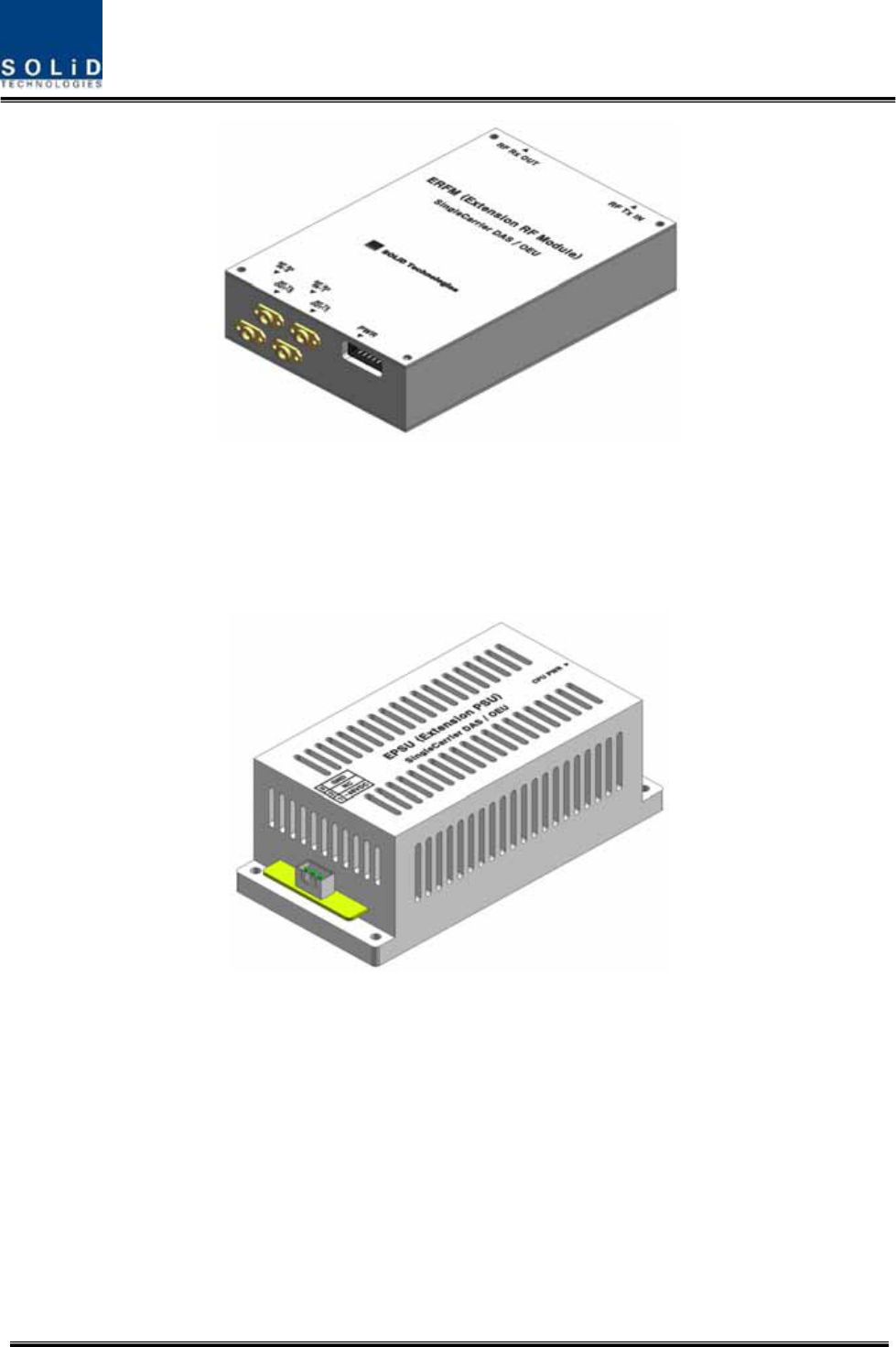
Confidential & Proprietary 43/116 SC-DAS
Figure 4.26 – ERFM Outer Look
5) Expansion Power Supply Unit(EPSU)
As DC/DC Converter, EPSU receives -48V of input and provides +9V and +6V of DC power required
for OEU.
Figure 4.27 – EPSU Outer Look
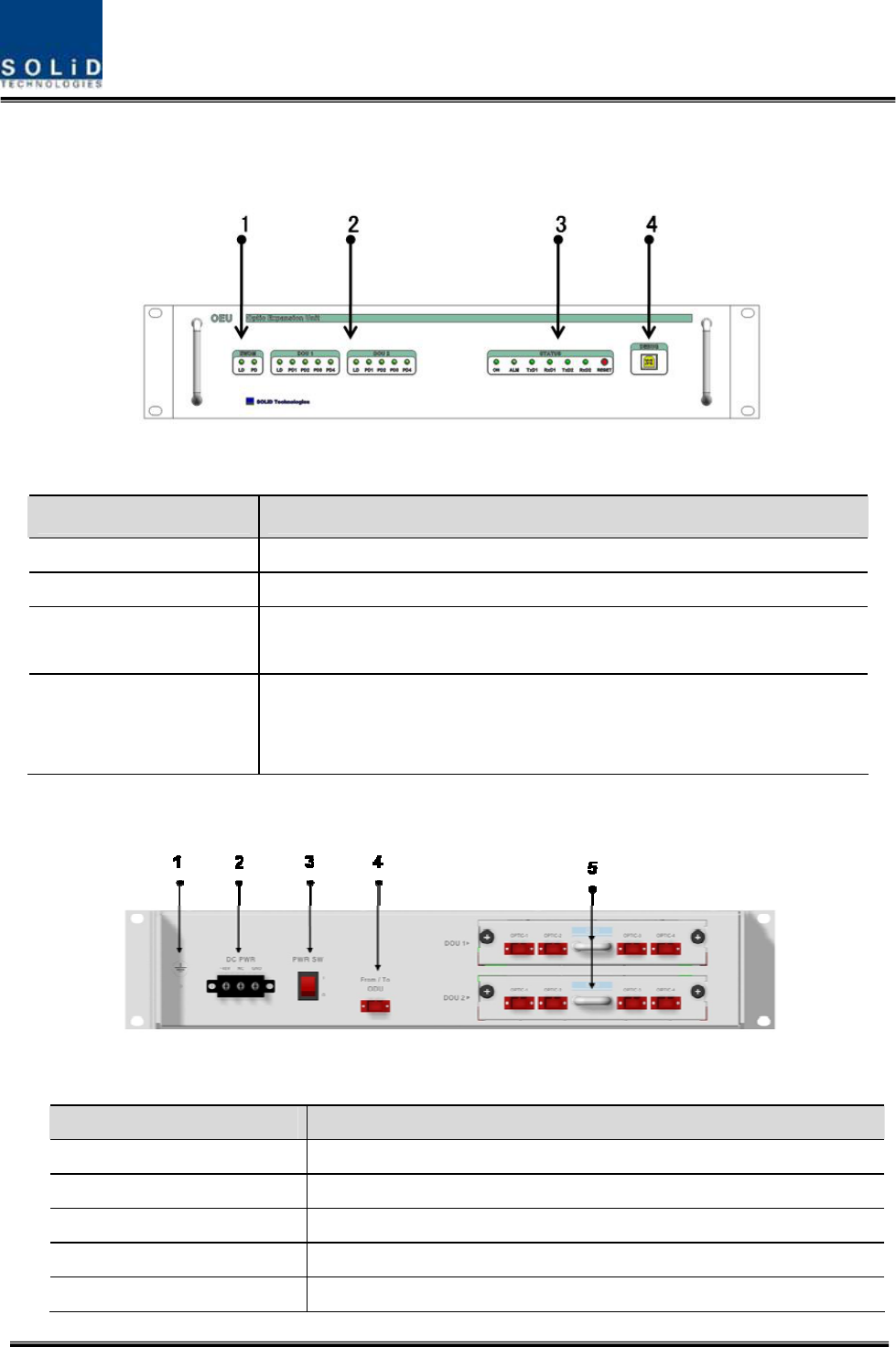
Confidential & Proprietary 44/116 SC-DAS
4.3.5 Front/rear panels of OEU
1) Front panel
Figure 4.28 – OEU front panel Outer Look
Item Description
1.EWDM LED LED indicator to check EWDM state to see if it is abnormal
2.DOU LED LED indicator to check DOU module state to see if it is abnormal
3.System LED and Reset Communication state with devices, alarm status of the system and reset
switch
4. NMS(USB Port)
USB port for communication and diagnosis of devices through PC/laptop.
This equipment is indoor use and all the communication wirings are limited to
inside of the building
2) Rear panel
Figure 4.29 – Rear panel Outer Look
Item Description
1. GND Port Terminal for system ground
2. DC Input Port Input terminal for DC -48V
3.power switch Power ON/OFF switch
4. To/From ODU Optic Port SC/APC optical connector terminal
5. To/From ROU Optic Port SC/APC optical connector terminal; use one optical cable per ROU.